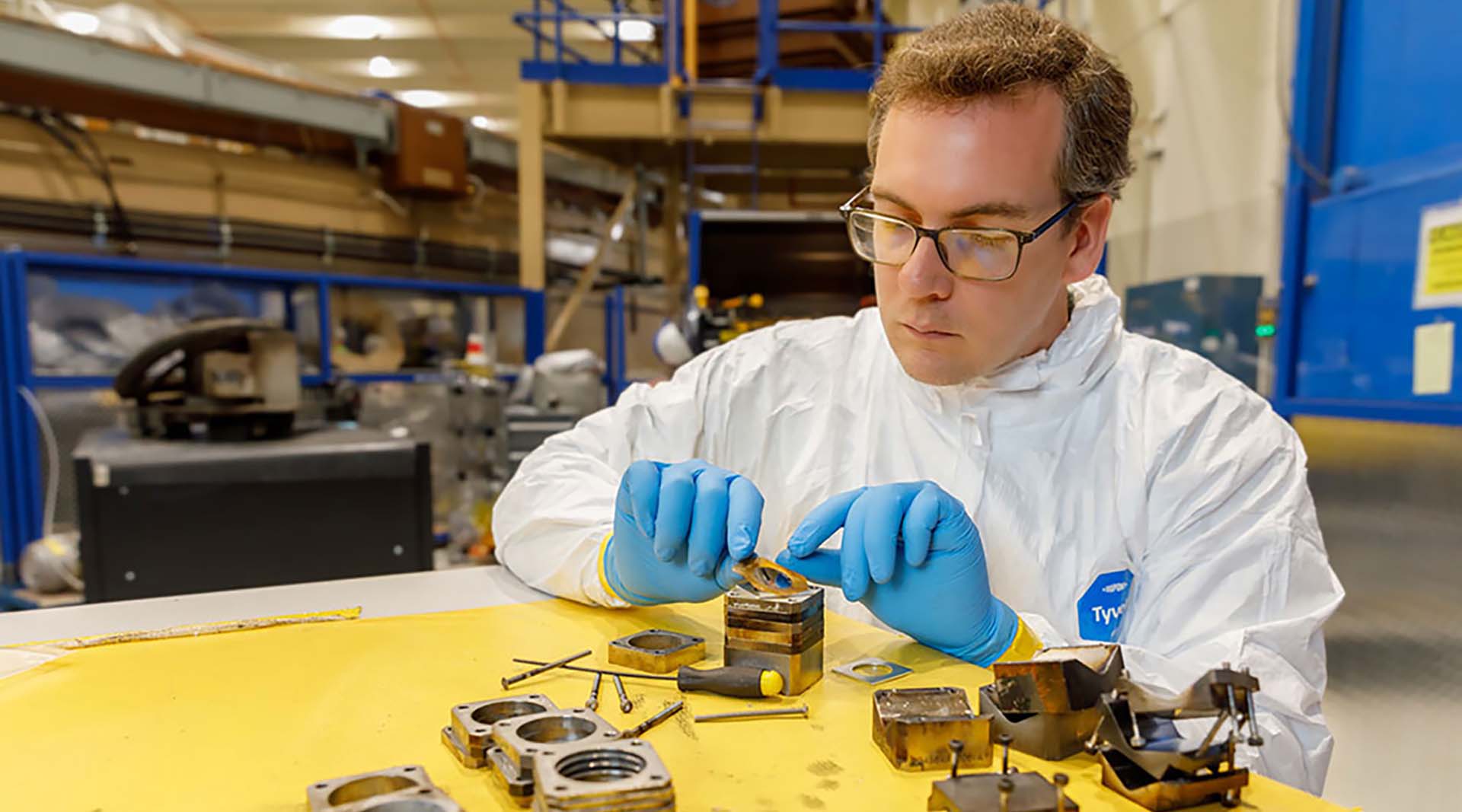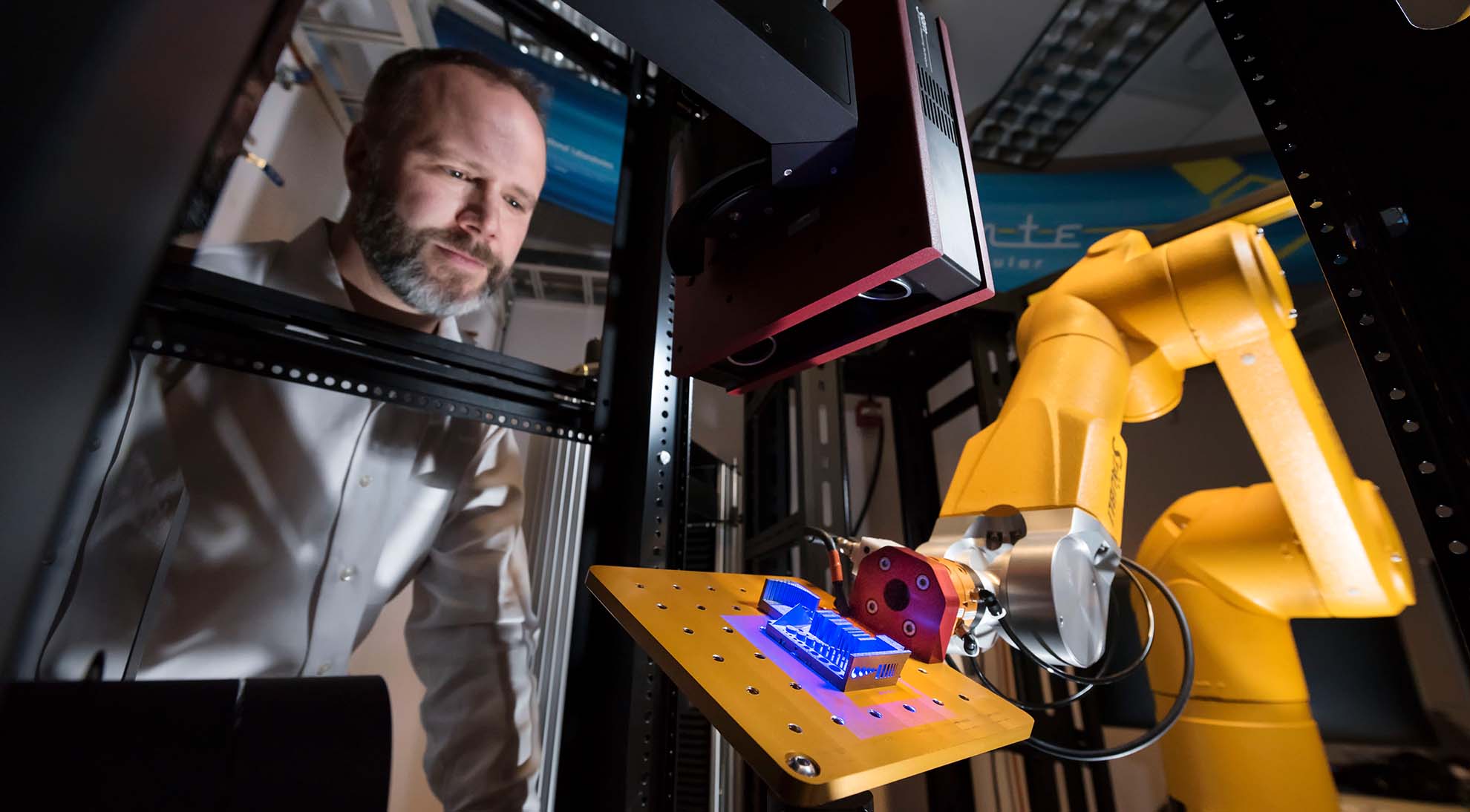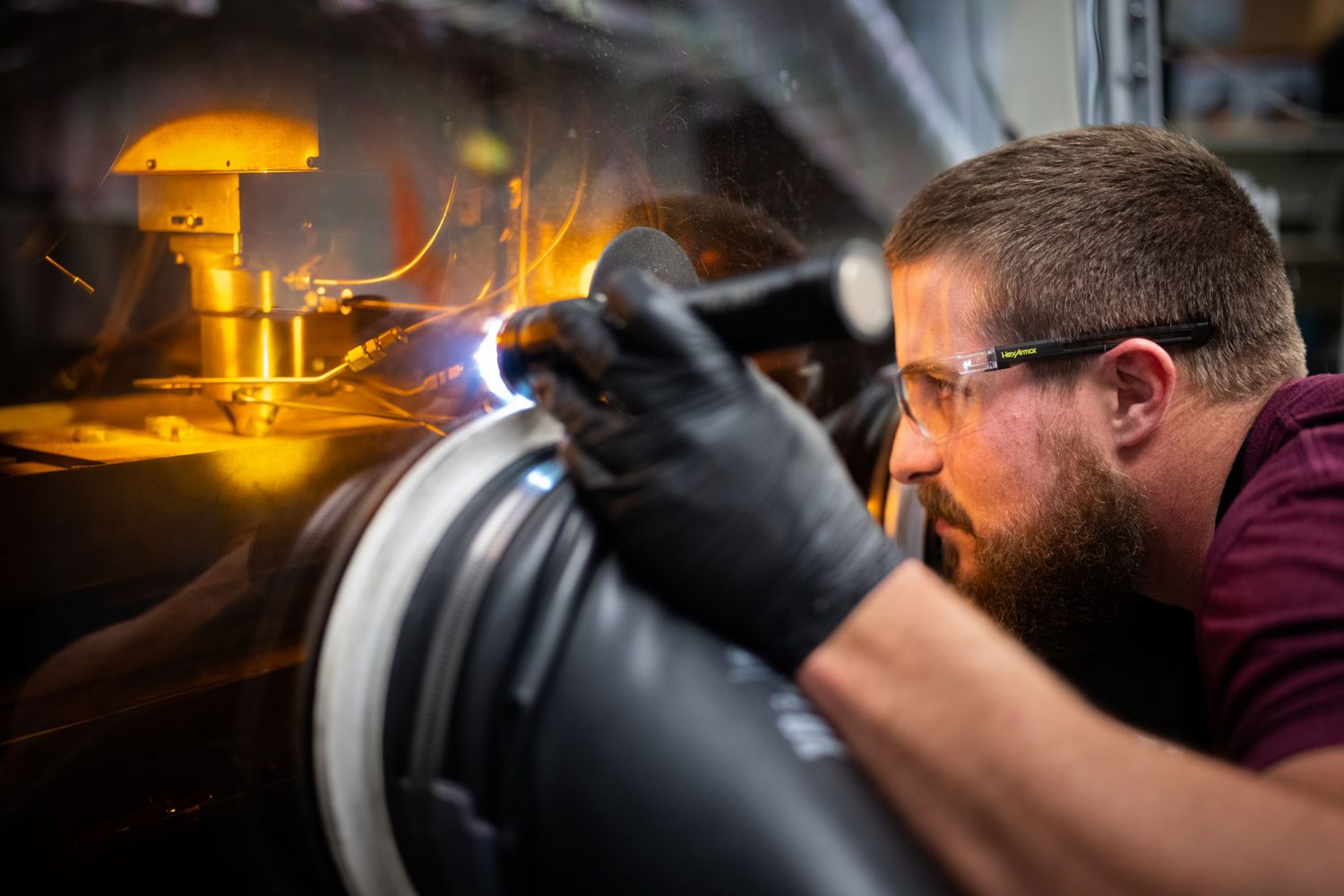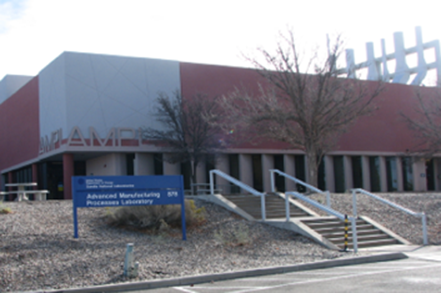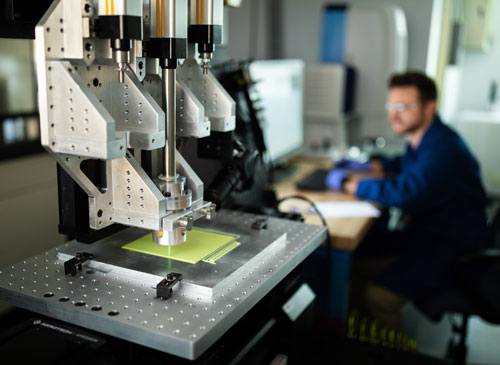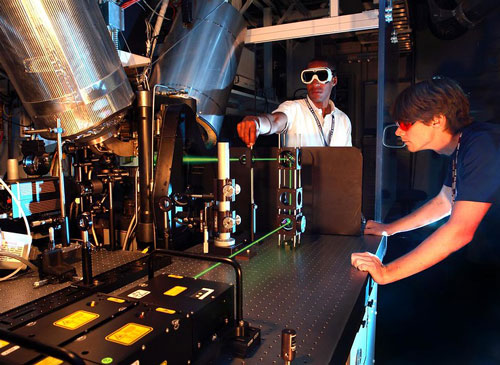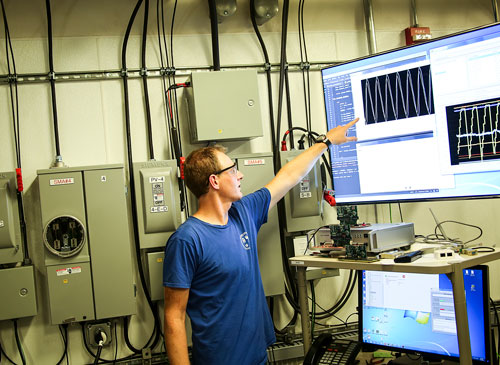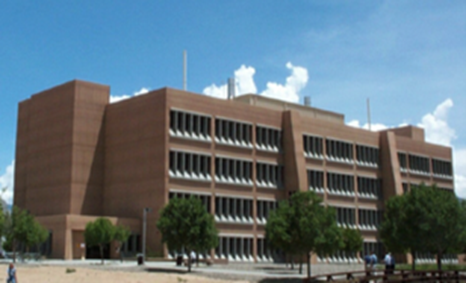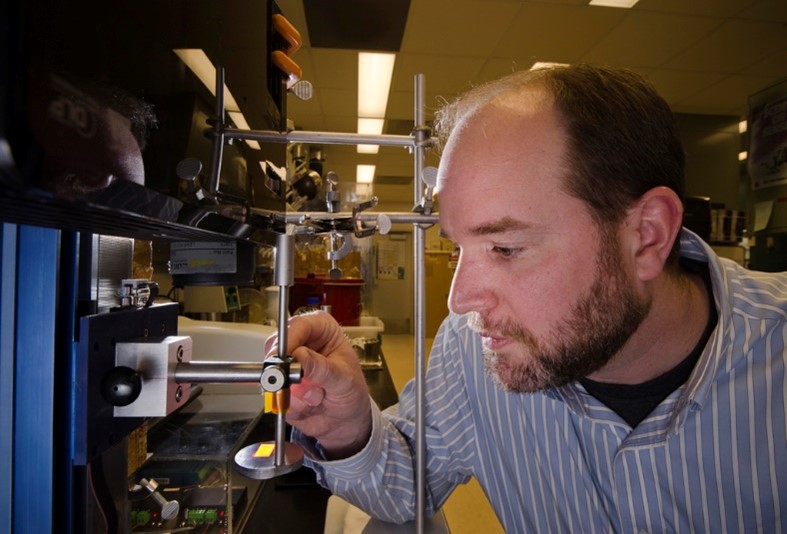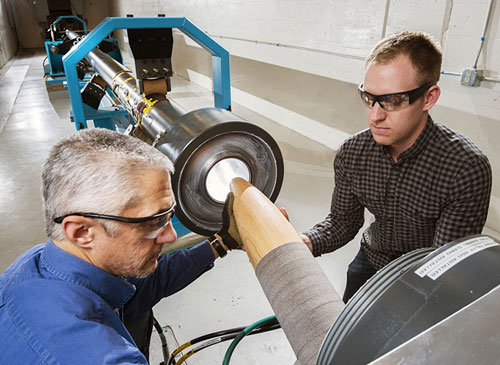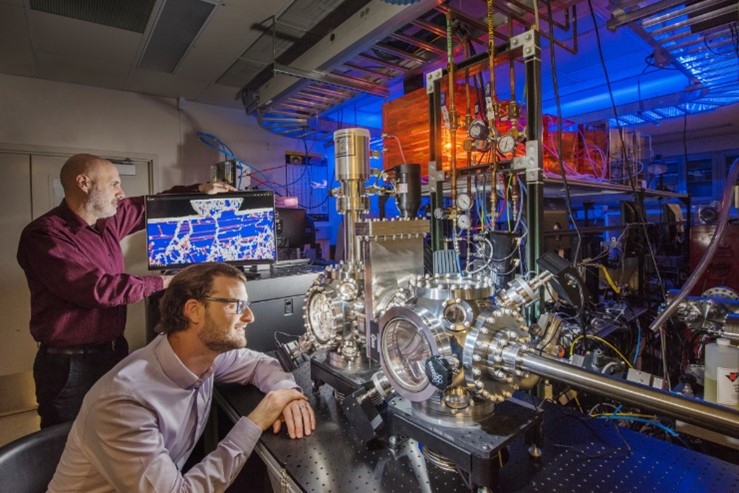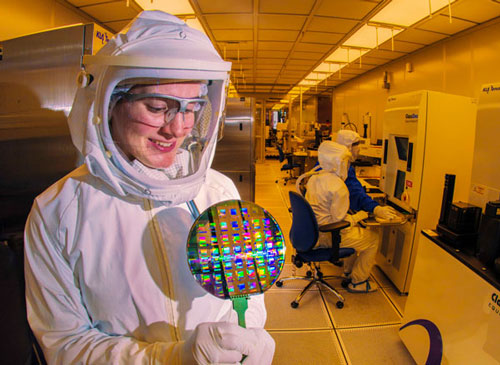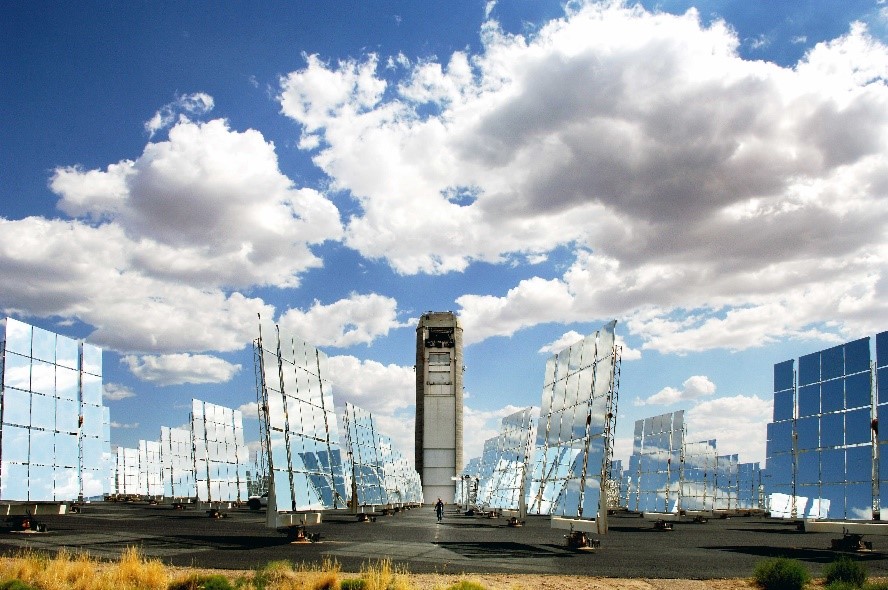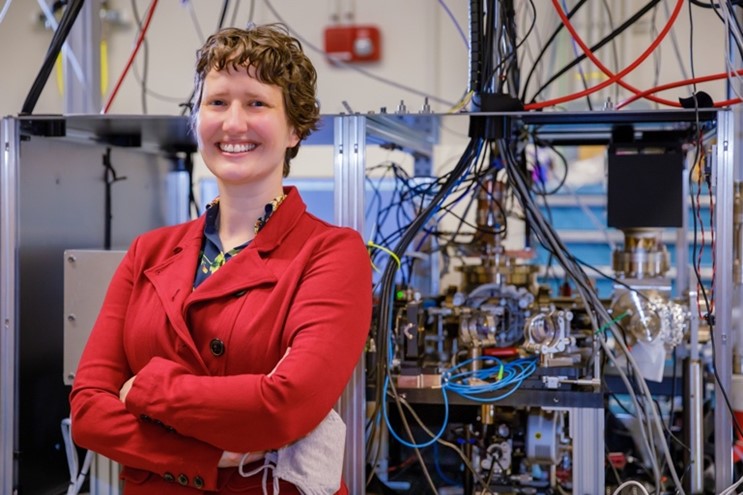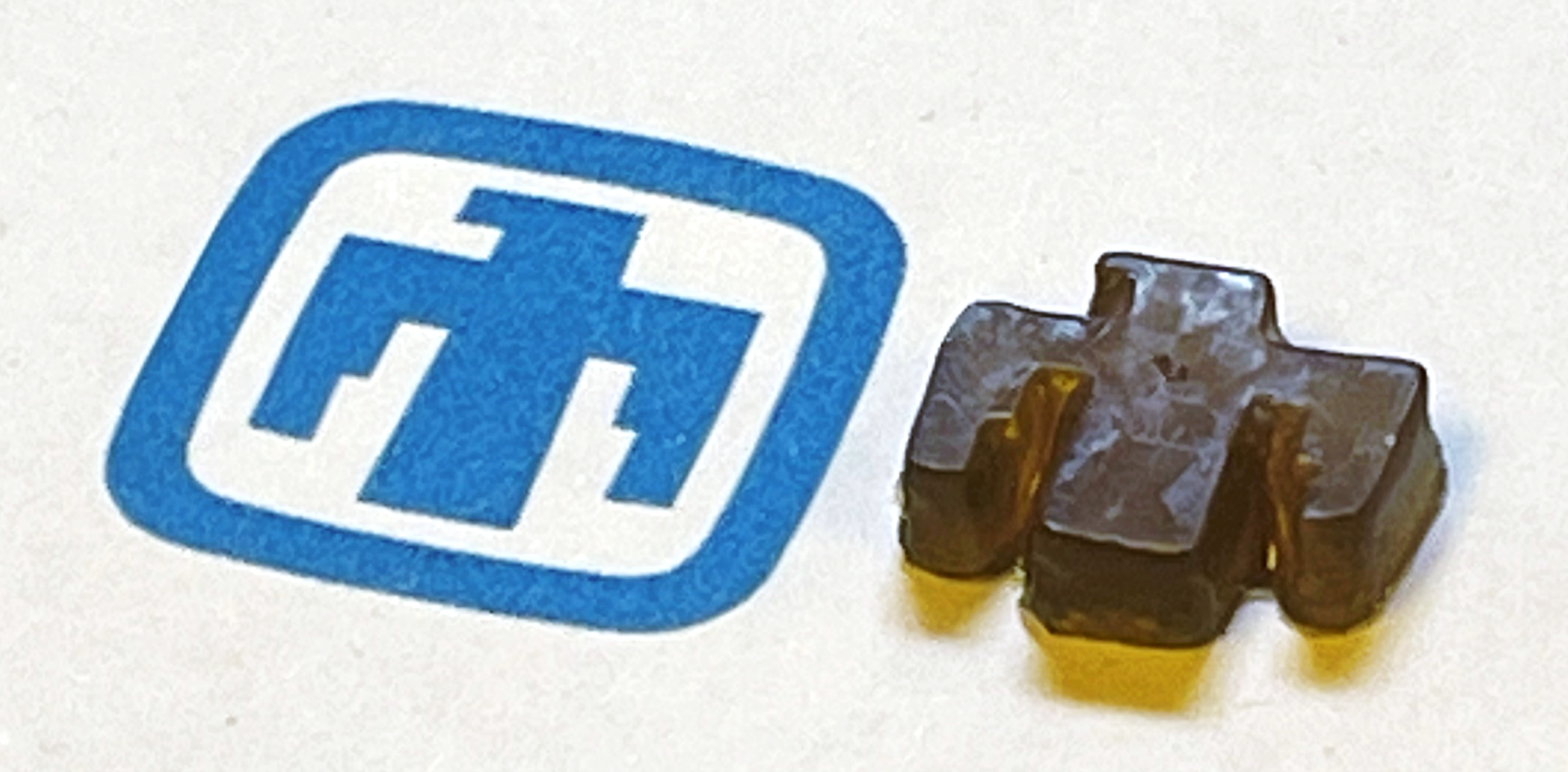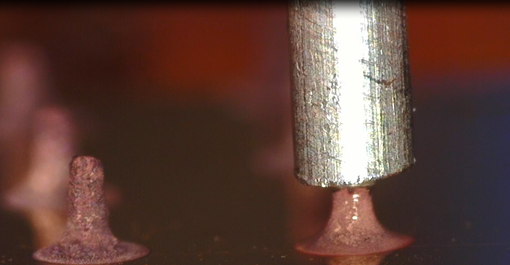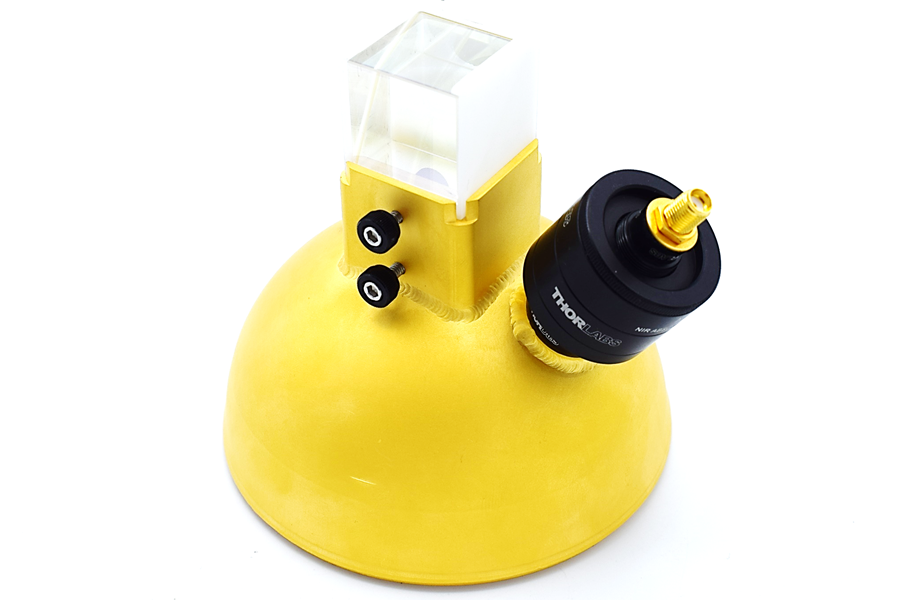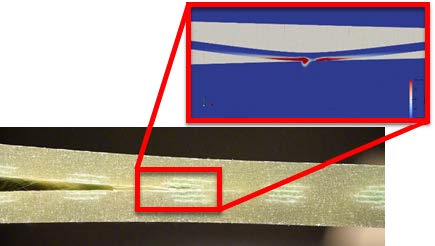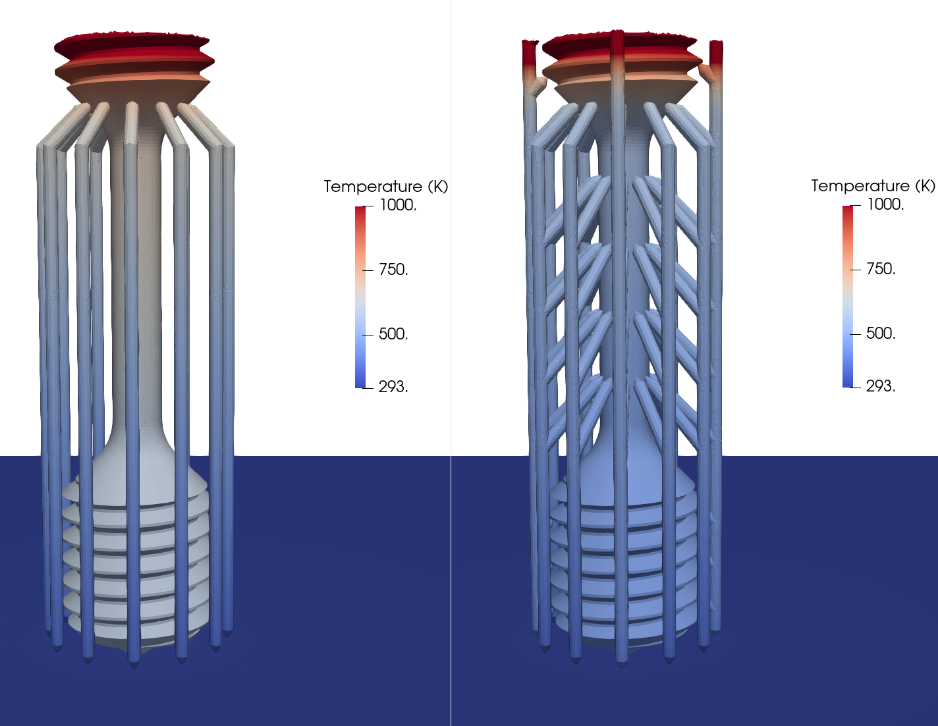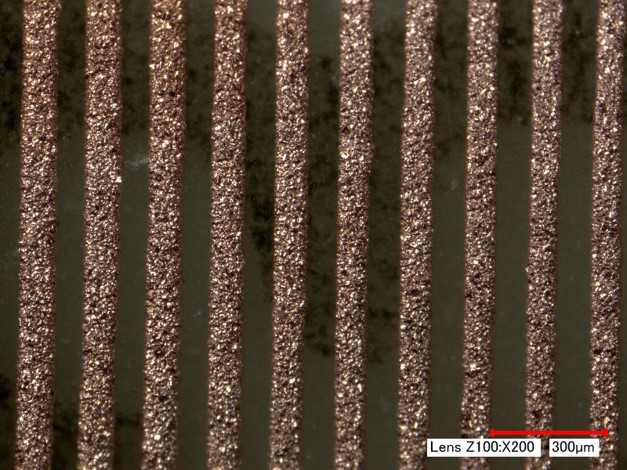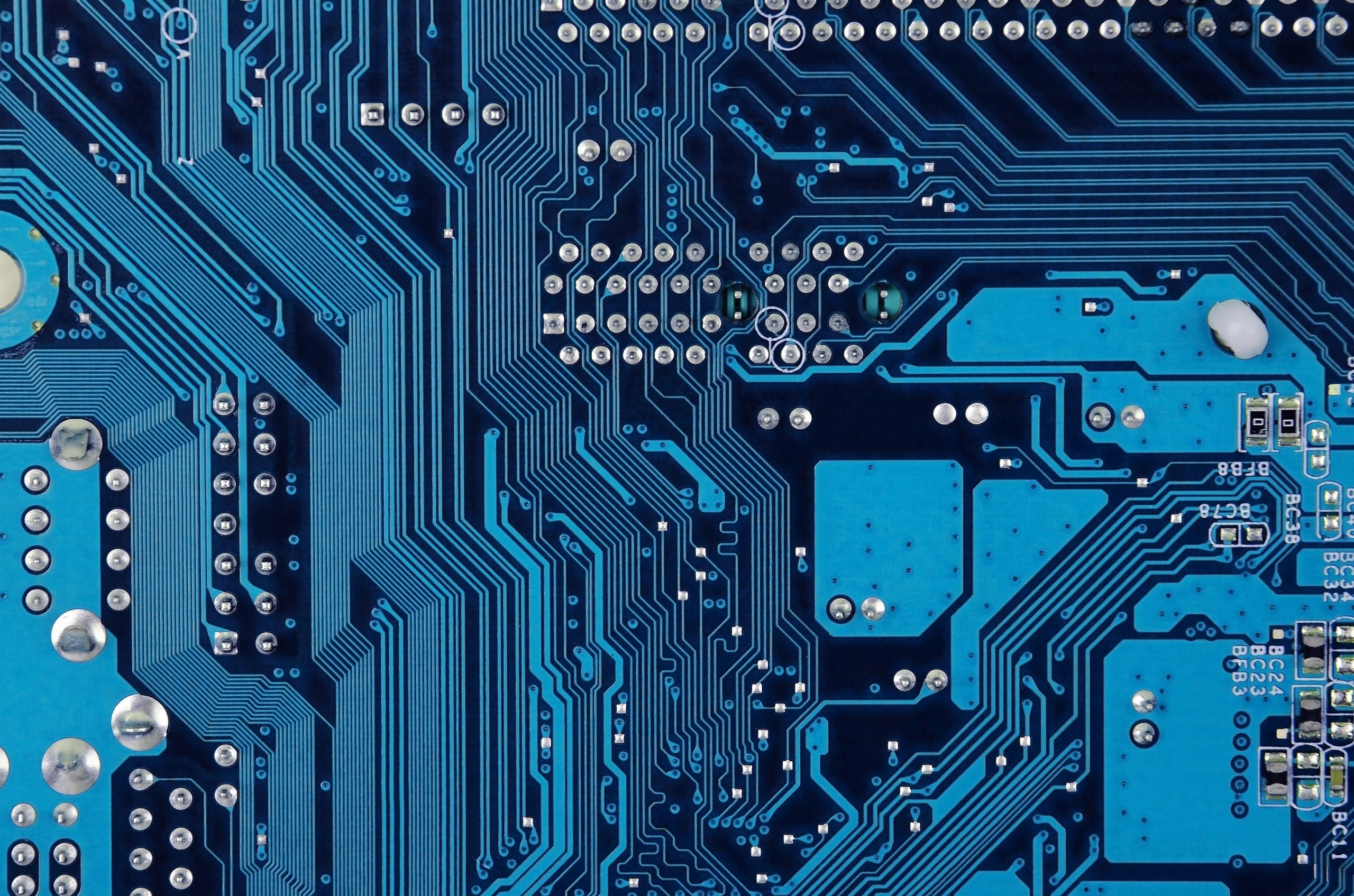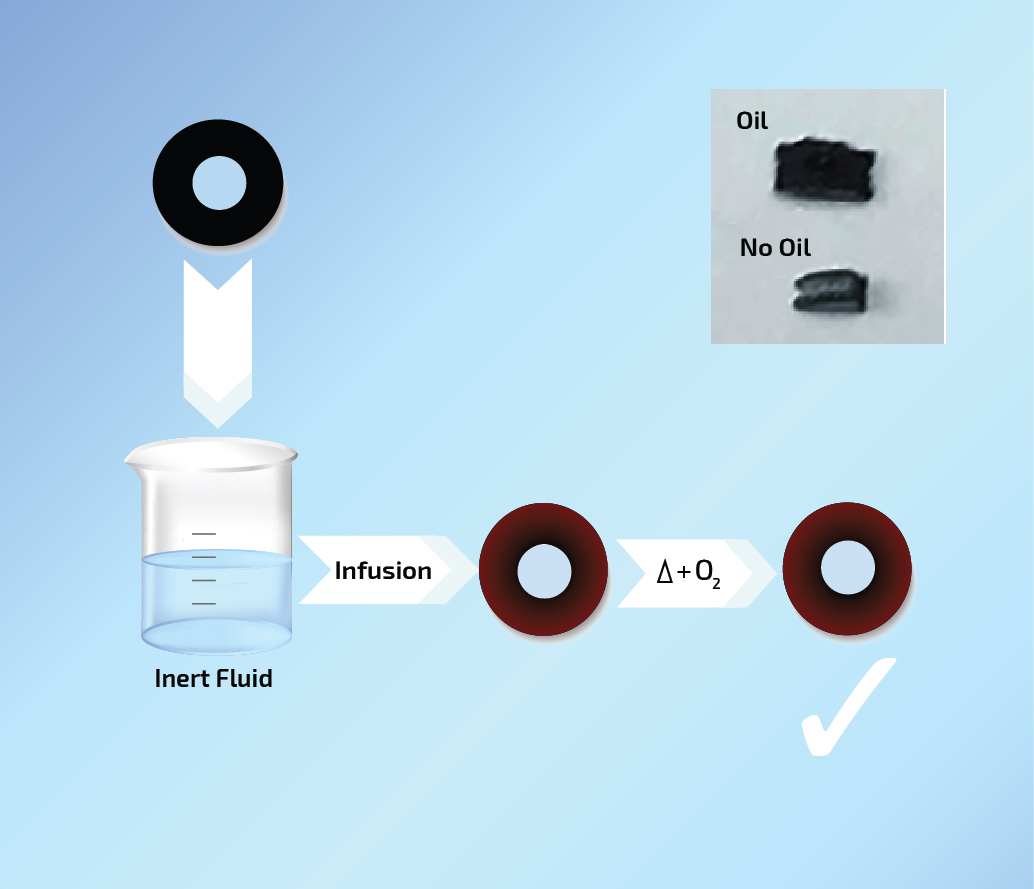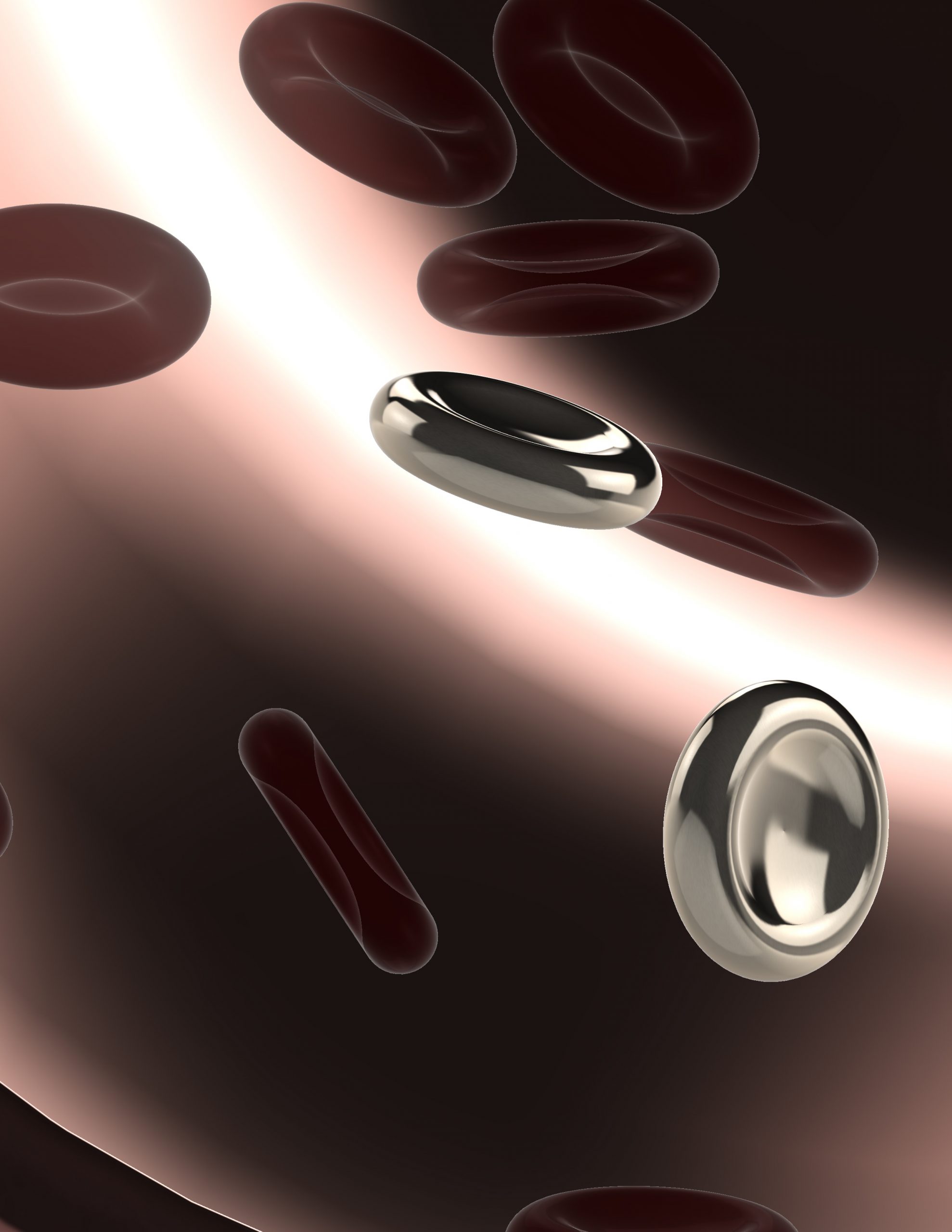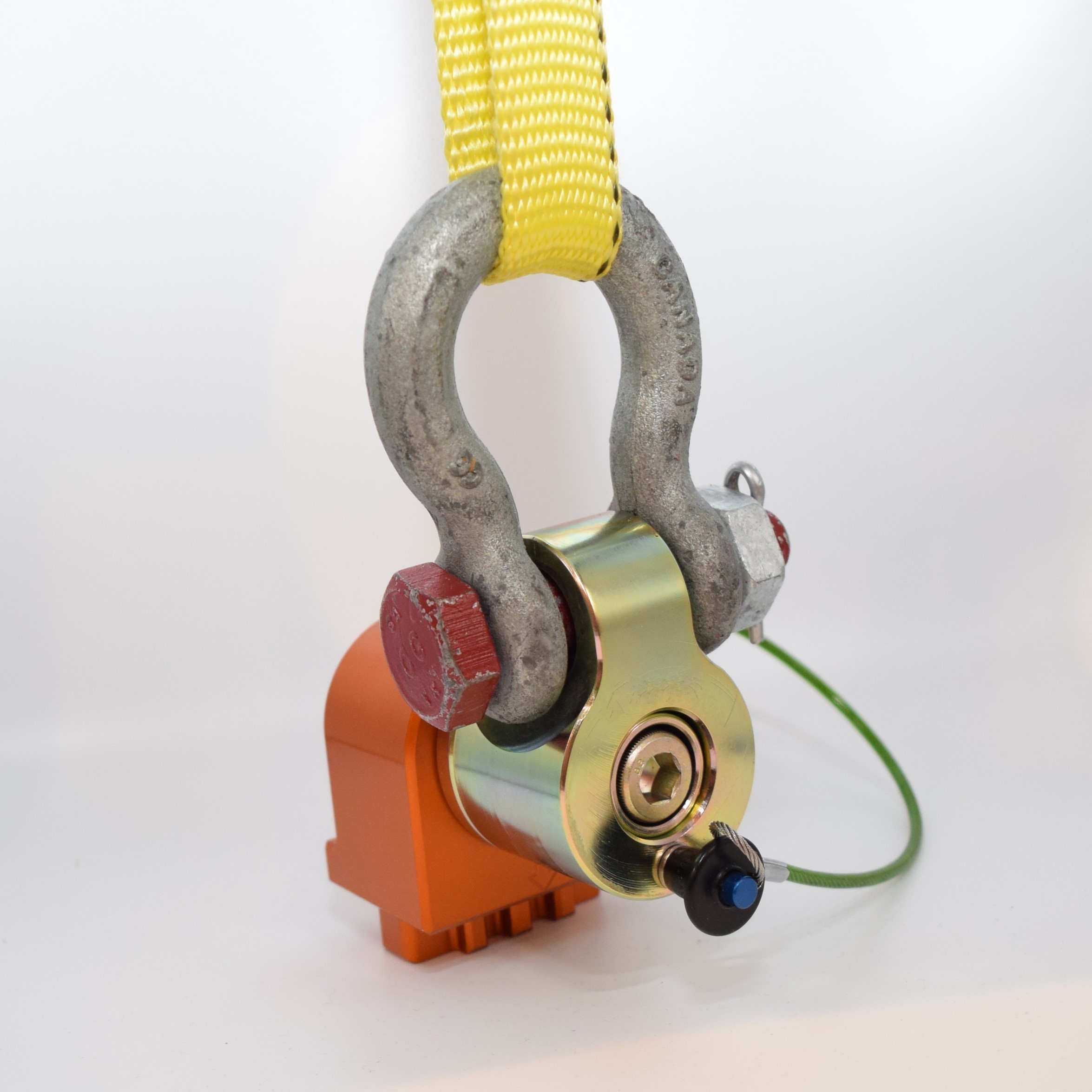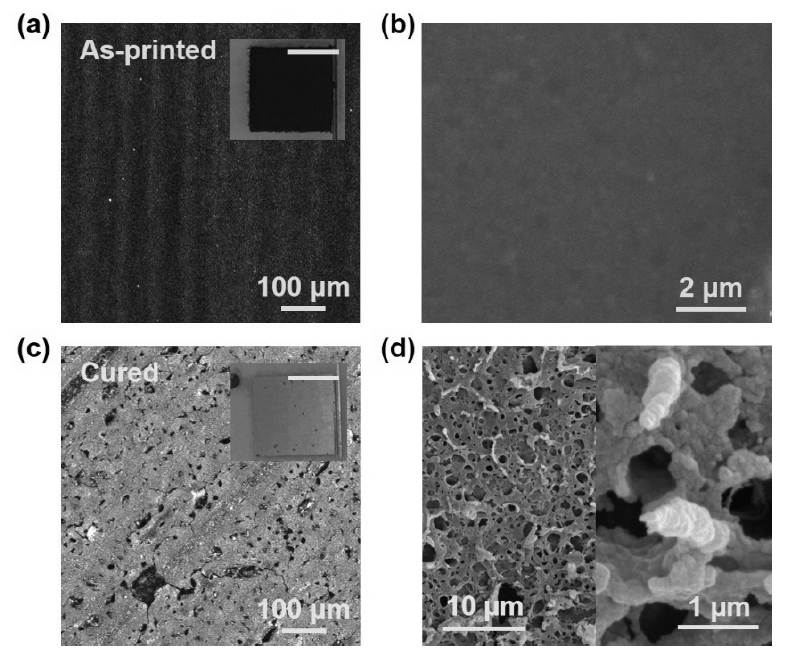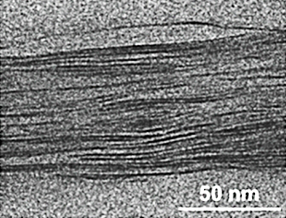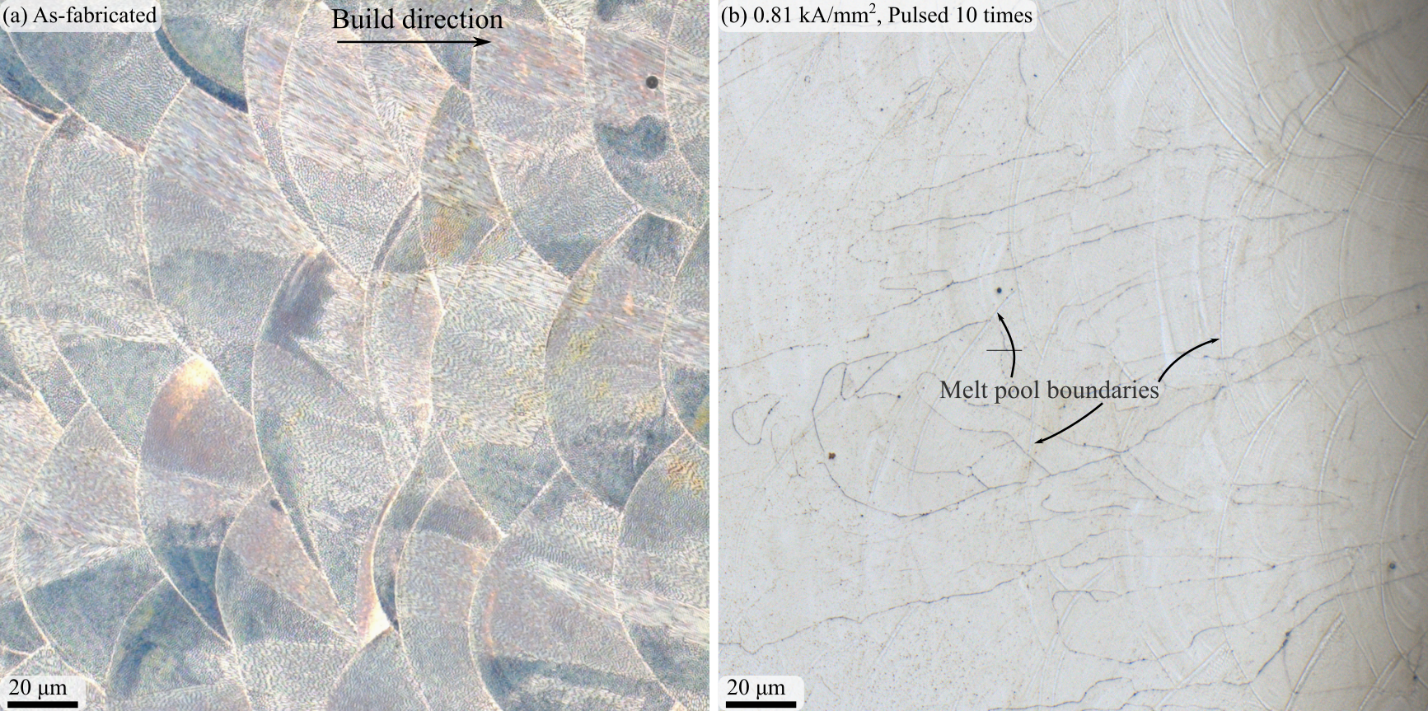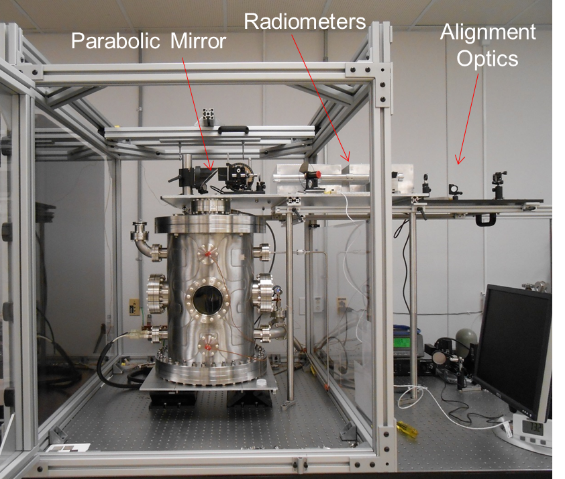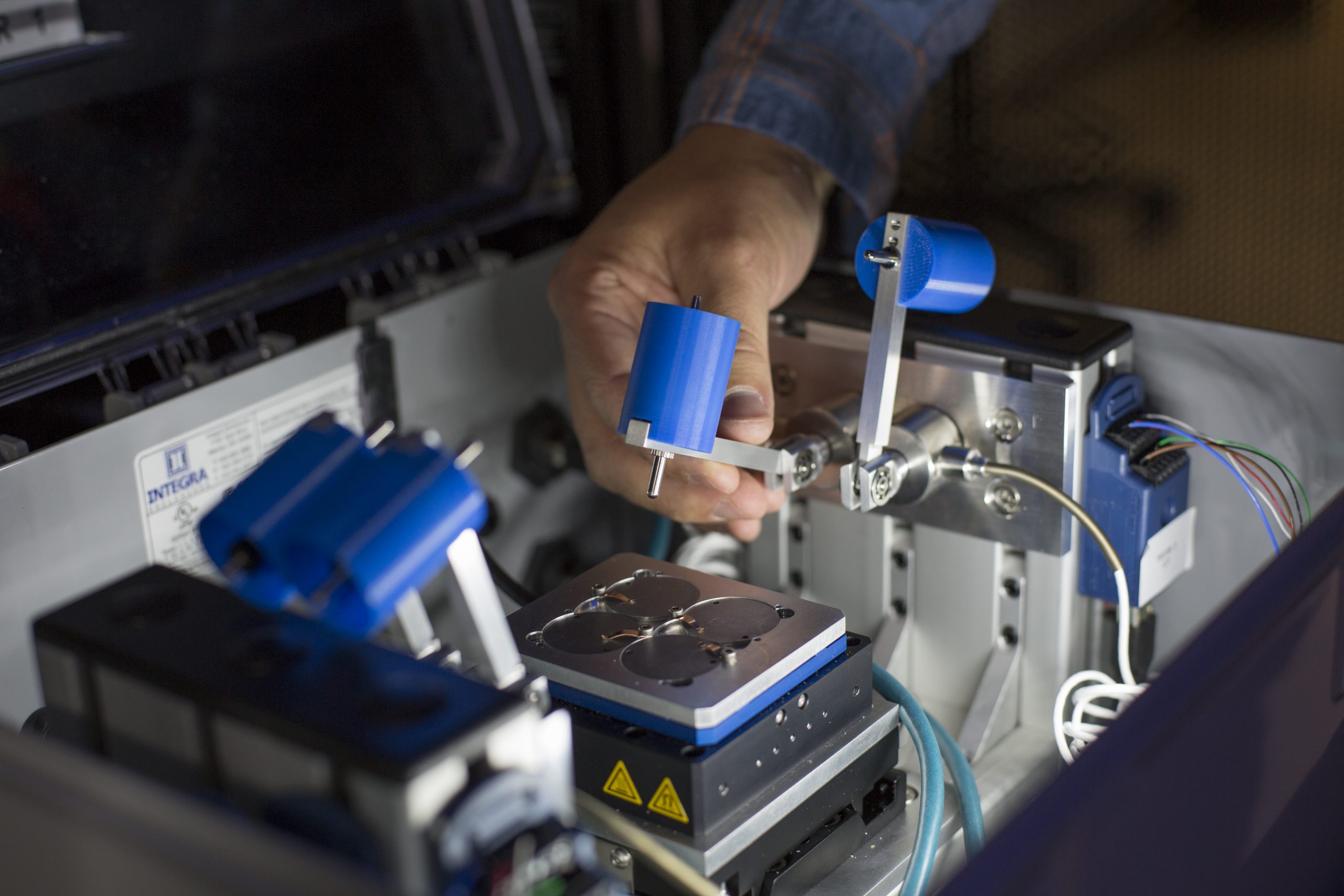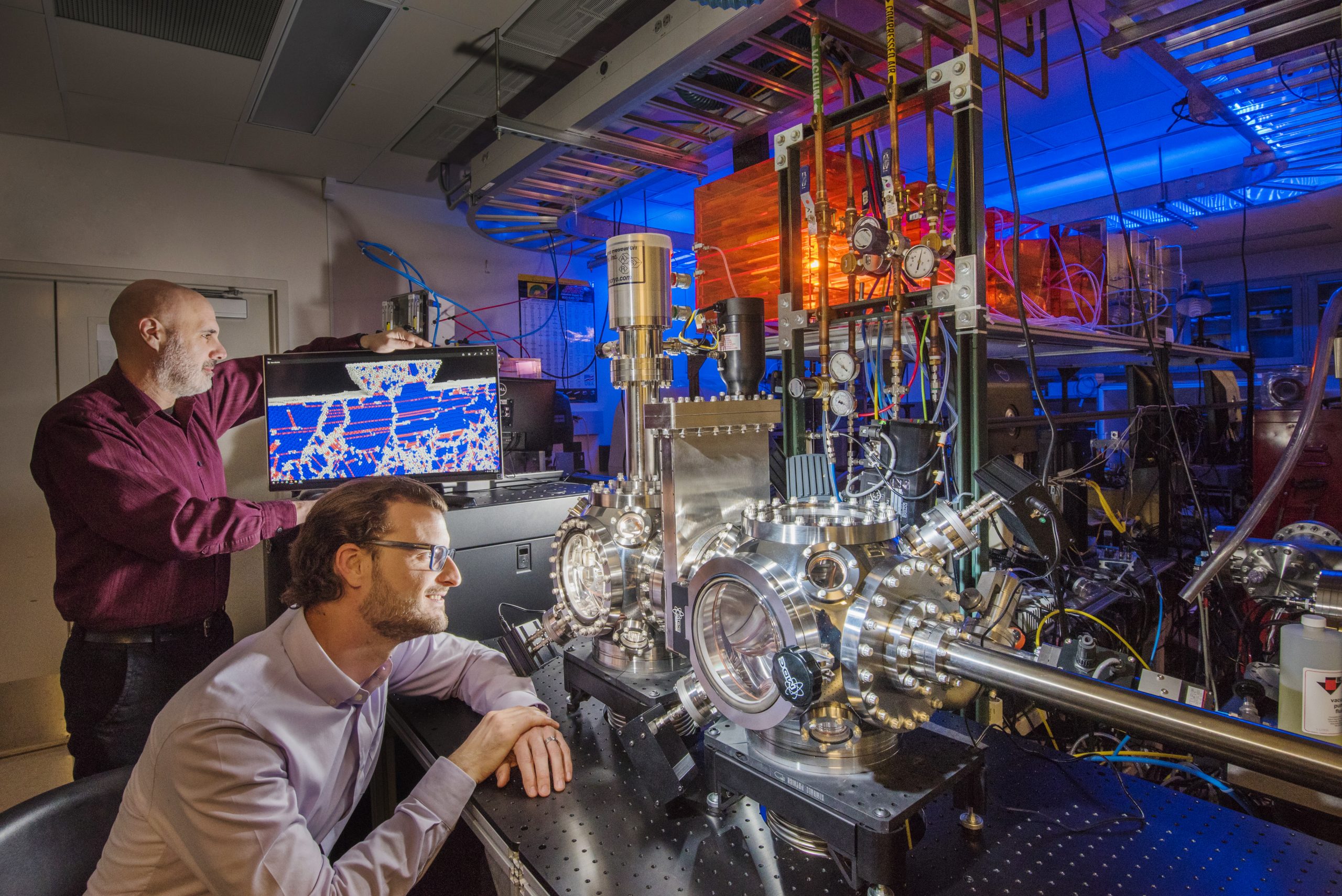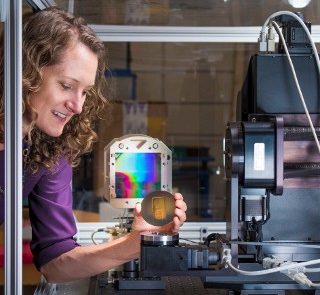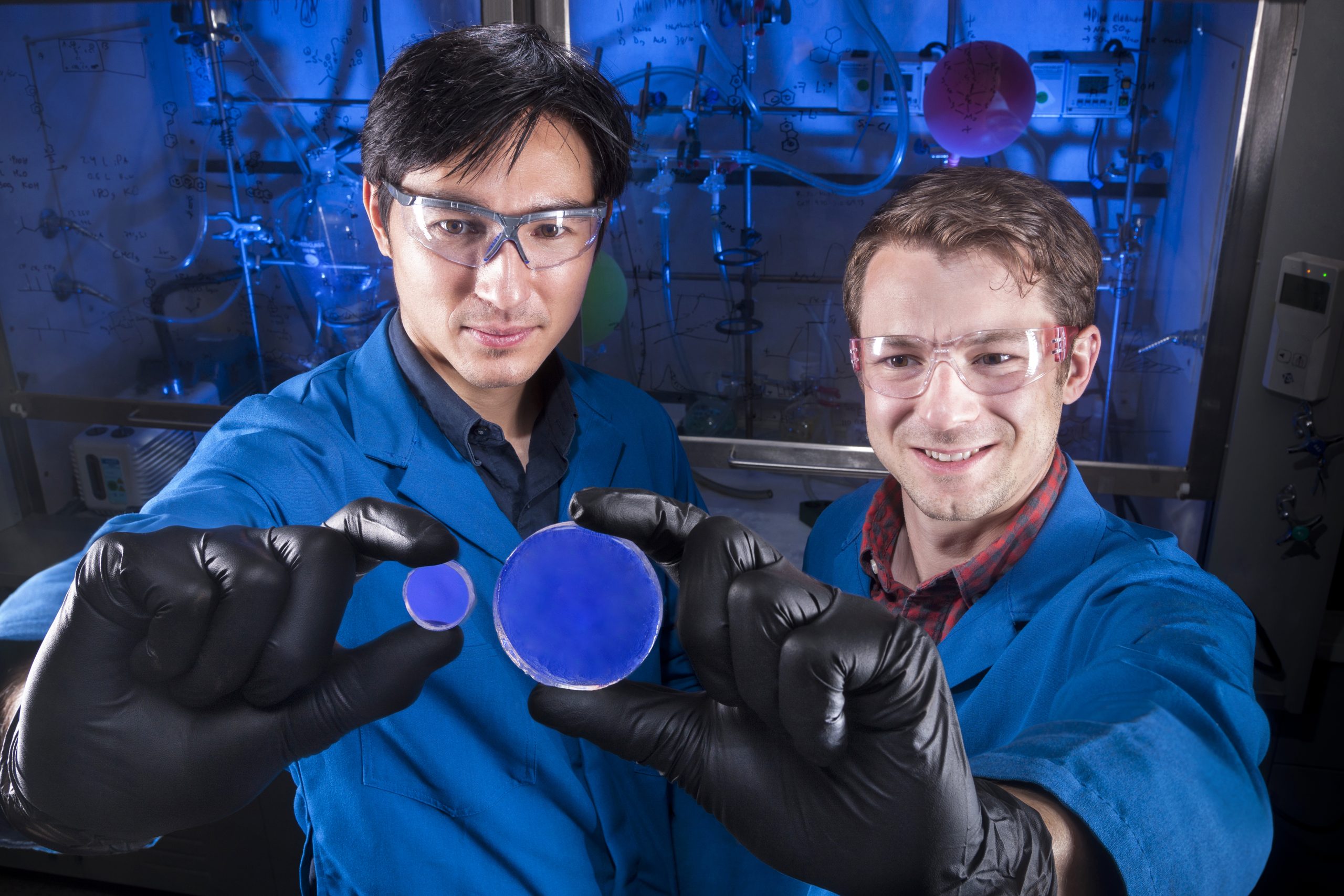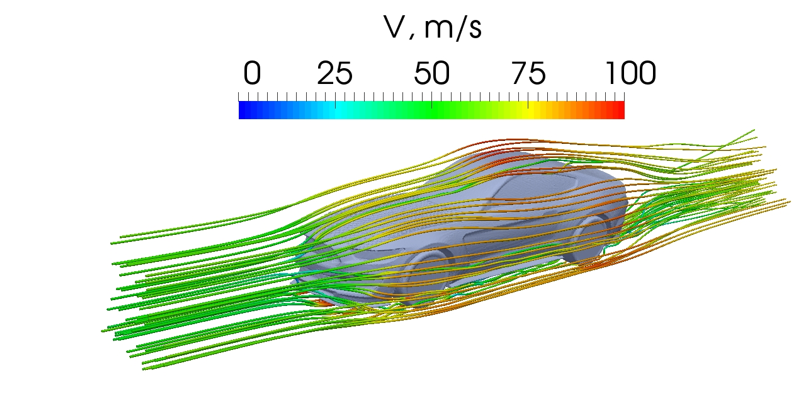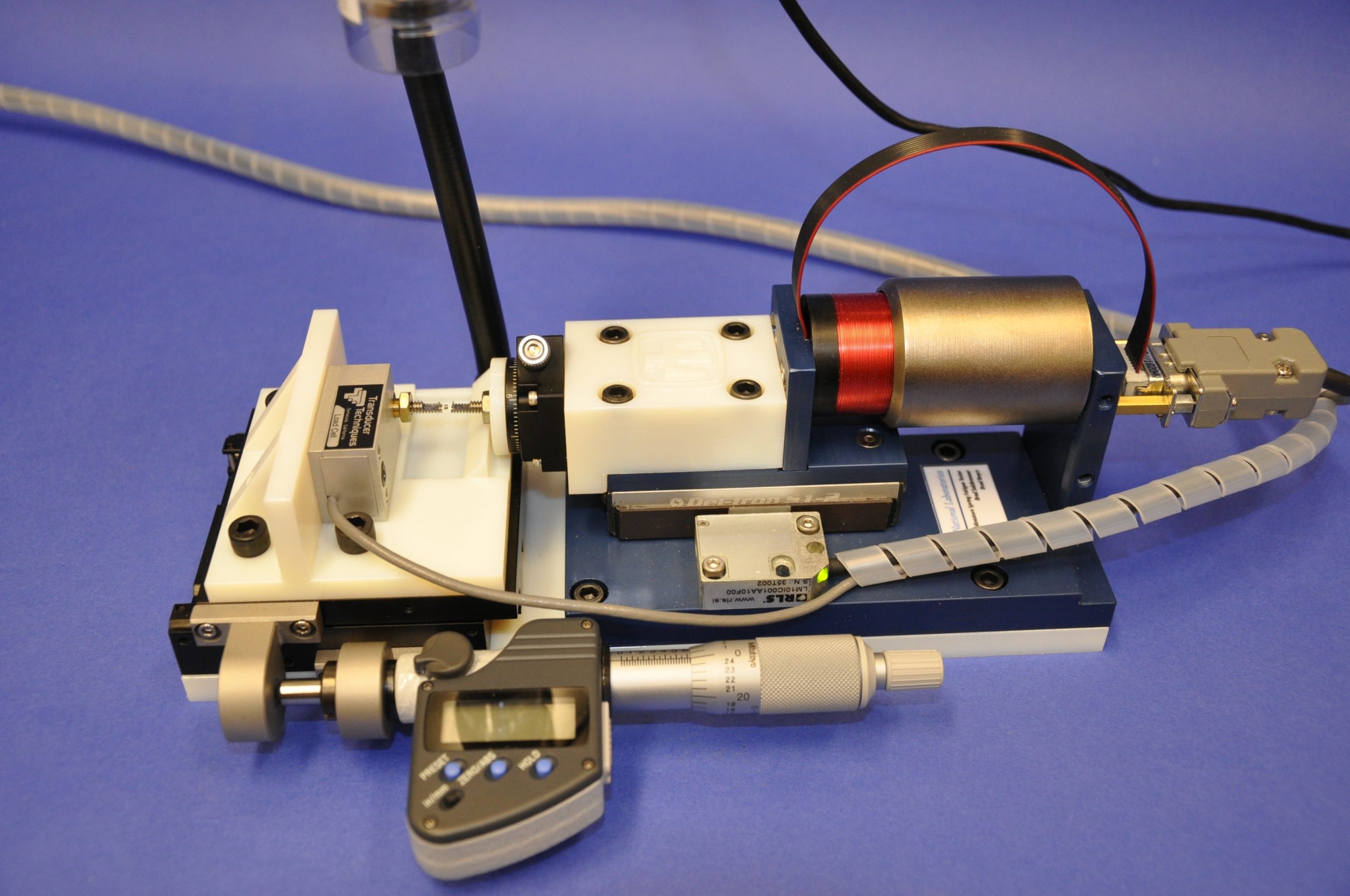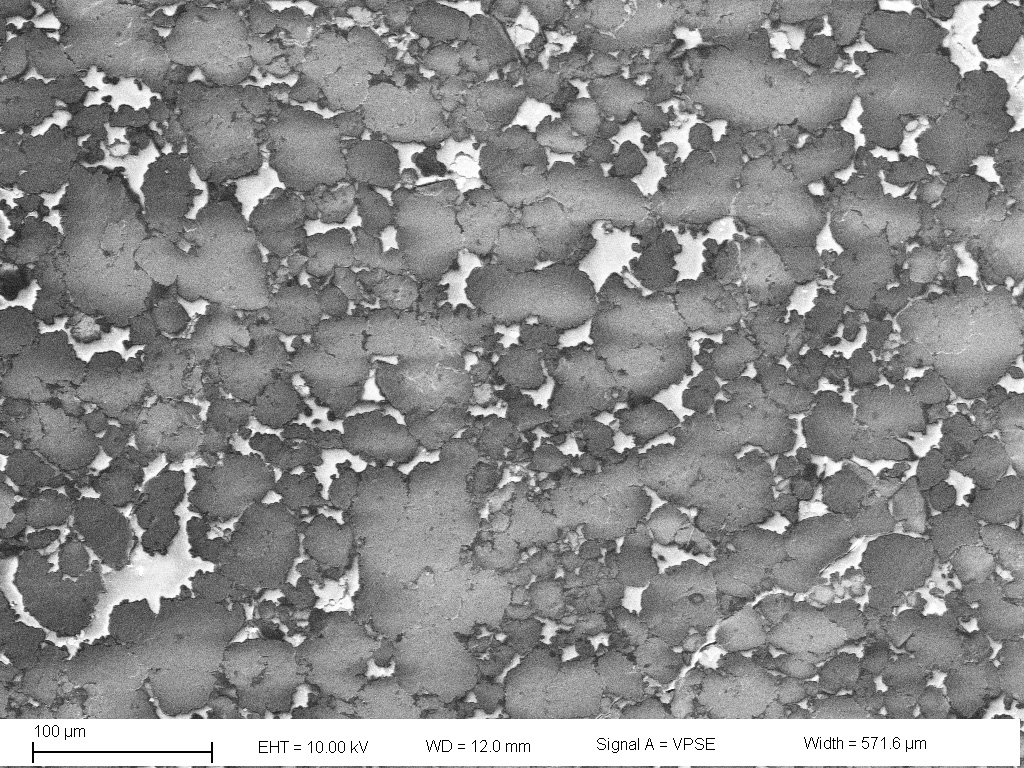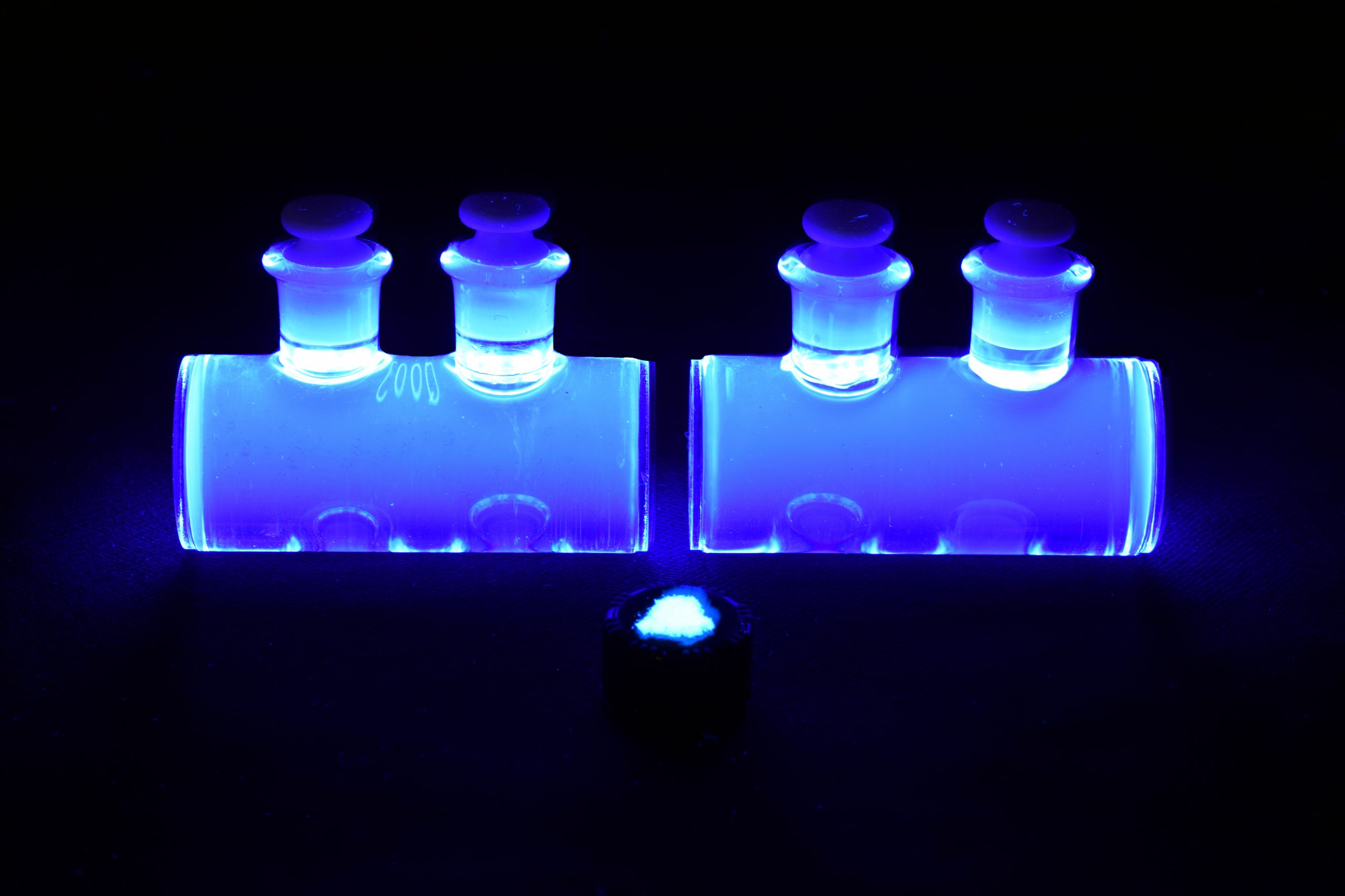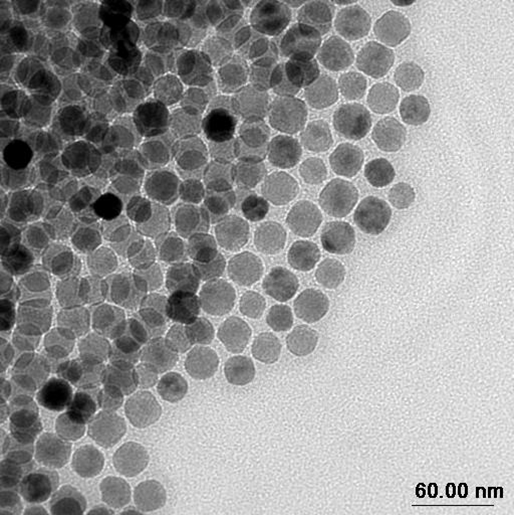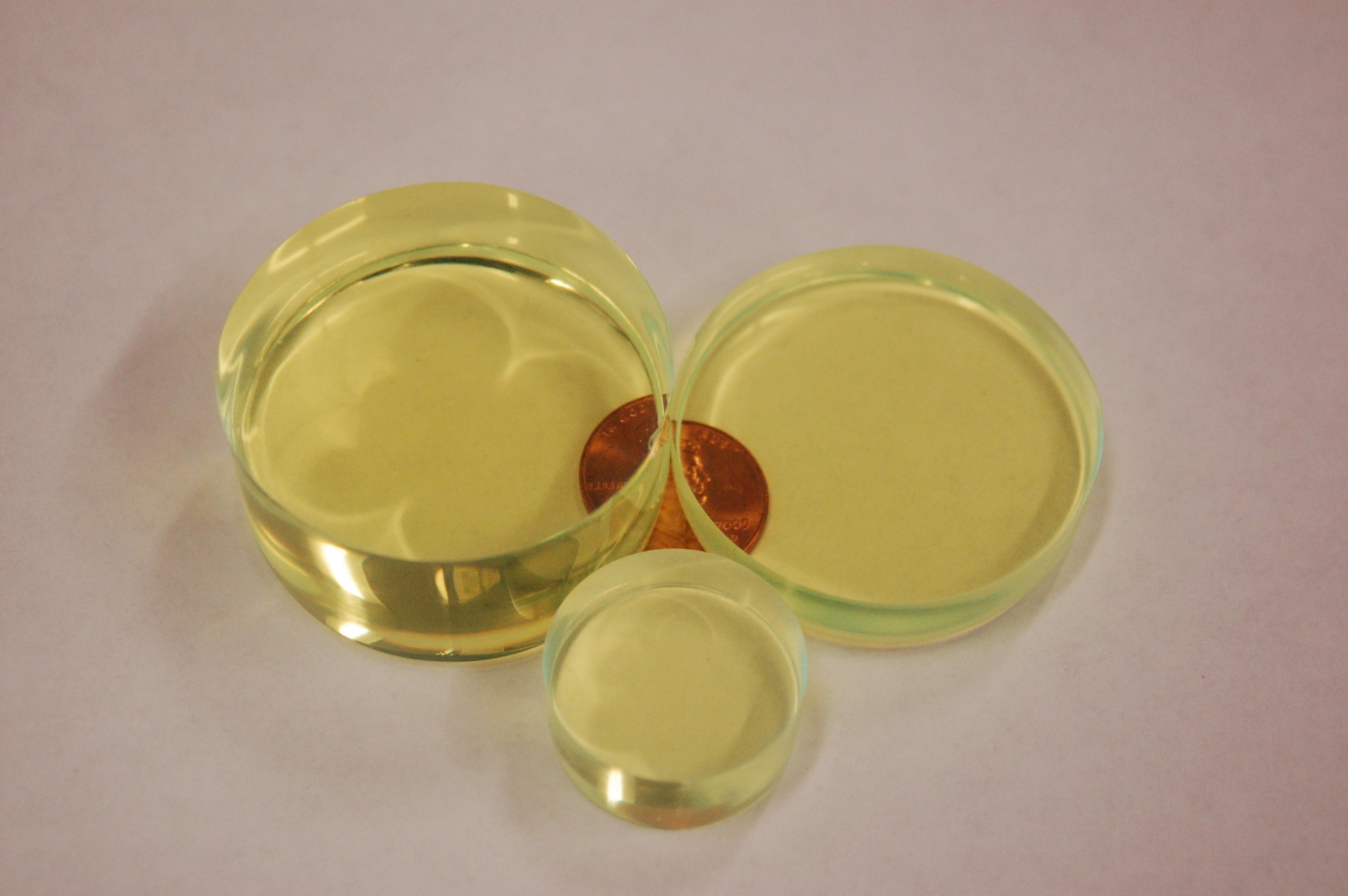| Use of latent metathesis polymerization systems for additive manufacturing |
11,840,586 |
12/12/2023
|
| Use of latent metathesis polymerization systems for additive manufacturing |
11,840,586 |
12/12/2023
|
| Structural metamaterials comprising interpenetrating lattices |
Pending |
11/28/2023
|
| Structural metamaterials comprising interpenetrating lattices |
Pending |
11/28/2023
|
| Use of latent metathesis polymerization systems for photopolymerization-based additive manufacturing |
11,820,839 |
11/21/2023
|
| Use of latent metathesis polymerization systems for photopolymerization-based additive manufacturing |
11,820,839 |
11/21/2023
|
| Optical tags comprising rare earth metal-organic frameworks |
Pending |
09/26/2023
|
| Refractory high entropy alloy compact heat exchanger |
Pending |
08/15/2023
|
| Method for Attaching Nanomaterials Comprising Hexagonal Lattices to Polymer Surfaces |
11,566,088 |
01/31/2023
|
| Method for Attaching Nanomaterials Comprising Hexagonal Lattices to Polymer Surfaces |
11,566,088 |
01/31/2023
|
| Poly(phenylene) with High Ion Selectivity for Use in Anion Exchange Membranes |
11,549,011 |
01/10/2023
|
| Poly(phenylene) with High Ion Selectivity for Use in Anion Exchange Membranes |
11,549,011 |
01/10/2023
|
| COMPUTATIONALLY OPTIMIZED AND MANUFACTURED ACOUSTIC METAMATERIALS |
11,498,282 |
11/15/2022
|
| COMPUTATIONALLY OPTIMIZED AND MANUFACTURED ACOUSTIC METAMATERIALS |
11,498,282 |
11/15/2022
|
| Electrocatalyst comprising a crumpled transition metal dichalcogenide support loaded with monodispersed metal nanoparticles |
11,484,867 |
11/01/2022
|
| Electrocatalyst comprising a crumpled transition metal dichalcogenide support loaded with monodispersed metal nanoparticles |
11,484,867 |
11/01/2022
|
| PASSIVE TUBE CLOSURE VALVE |
11,473,689 |
10/18/2022
|
| PASSIVE TUBE CLOSURE VALVE |
11,473,689 |
10/18/2022
|
| PASSIVE TUBE CLOSURE VALVE |
11,473,689 |
10/18/2022
|
| High Entropy Alloys, Refractory High Entropy Alloys, Methods of Selecting and Making, and Structures Formed Thereof |
11,434,551 |
09/06/2022
|
| High Entropy Alloys, Refractory High Entropy Alloys, Methods of Selecting and Making, and Structures Formed Thereof |
11,434,551 |
09/06/2022
|
| Superconductivity device comprising a phononic crystal |
11,424,400 |
08/23/2022
|
| Superconductivity device comprising a phononic crystal |
11,424,400 |
08/23/2022
|
| HYBRID PIEZOELECTRIC MICRORESONATOR |
11,387,802 |
07/12/2022
|
| DUCTILE COATINGS ON ADDITIVE MANUFACTURED COMPONENTS |
11,377,750 |
07/05/2022
|
| DUCTILE COATINGS ON ADDITIVE MANUFACTURED COMPONENTS |
11,377,750 |
07/05/2022
|
| THERMAL MEASUREMENT APPARATUS AND METHODS FOR ANISOTROPIC THERMAL MATERIALS |
11,371,949 |
06/28/2022
|
| Thin-Film Target for DT Neutron Production |
11,343,900 |
05/24/2022
|
| TOTAL-INTERNAL REFLECTION ELASTIC METASURFACES: DESIGN AND APPLICATION |
11,339,845 |
05/24/2022
|
| Thin-Film Target for DT Neutron Production |
11,343,900 |
05/24/2022
|
| EFFICIENT ULTRATHIN ALL-DIELECTRIC NONLINEAR OPTICAL DEVICE |
11,314,145 |
04/26/2022
|
| EFFICIENT ULTRATHIN ALL-DIELECTRIC NONLINEAR OPTICAL DEVICE |
11,314,145 |
04/26/2022
|
| Mode I fracture testing fixture |
11,298,754 |
04/12/2022
|
| Mode I fracture testing fixture |
11,298,754 |
04/12/2022
|
| Injection withdrawal tracer tests to assess proppant placement |
11,294,349 |
04/05/2022
|
| Injection withdrawal tracer tests to assess proppant placement |
11,294,349 |
04/05/2022
|
| SOLID STATE SYNTHESIS OF METAL BOROHYDRIDES |
11,267,702 |
03/08/2022
|
| SOLID STATE SYNTHESIS OF METAL BOROHYDRIDES |
11,267,702 |
03/08/2022
|
| Molten Inorganic Electrolytes for Low Temperature Sodium Batteries |
11,258,096 |
02/22/2022
|
| Molten Inorganic Electrolytes for Low Temperature Sodium Batteries |
11,258,096 |
02/22/2022
|
| Molten Inorganic Electrolytes for Low Temperature Sodium Batteries |
11,258,096 |
02/22/2022
|
| Gallium Nitride Electromagnetic Pulse Arrestor |
11,227,844 |
01/18/2022
|
| Gallium Nitride Electromagnetic Pulse Arrestor |
11,227,844 |
01/18/2022
|
| Method for fabricating embedded nanostructures with arbitrary shape |
11,222,950 |
01/11/2022
|
| Method for fabricating embedded nanostructures with arbitrary shape |
11,222,950 |
01/11/2022
|
| FRICTION TESTING AND TORQUE SENSING SYSTEMS |
11,199,485 |
12/14/2021
|
| FRICTION TESTING AND TORQUE SENSING SYSTEMS |
11,199,485 |
12/14/2021
|
| LOCKING SIDE PULL HOIST RING ASSEMBLY |
11,192,760 |
12/07/2021
|
| TERNARY BORIDES AND BOROHYDRIDES FOR HYDROGEN STORAGE AND METHOD OF SYNTHESIS |
11,192,783 |
12/07/2021
|
| TERNARY BORIDES AND BOROHYDRIDES FOR HYDROGEN STORAGE AND METHOD OF SYNTHESIS |
11,192,783 |
12/07/2021
|
| LOCKING SIDE PULL HOIST RING ASSEMBLY |
11,192,760 |
12/07/2021
|
| ADDITIVELY MANUFACTURED LOCALLY RESONANT INTERPENETRATING LATTICE STRUCTURE |
11,195,504 |
12/07/2021
|
| Surface Treatment of Ultra-High Molecular Weight Polymers |
11,186,945 |
11/30/2021
|
| FILTRATION MEMBRANES |
11,167,250 |
11/09/2021
|
| FILTRATION MEMBRANES |
11,167,250 |
11/09/2021
|
| MULTILAYER SOLID LUBRICANT ARCHITECTURE FOR USE IN DRILLING TOOL APPLICATIONS |
11,156,033 |
10/26/2021
|
| MULTILAYER SOLID LUBRICANT ARCHITECTURE FOR USE IN DRILLING TOOL APPLICATIONS |
11,156,033 |
10/26/2021
|
| SELF-ASSEMBLY ASSISTED ADDITIVE MANUFACTURING OF THERMOSETS |
11,149,108 |
10/19/2021
|
| Polarization-based coding/encryption using organic charge-transfer materials |
11,151,345 |
10/19/2021
|
| ENHANCED COMPOSITES VIA SELECTIVE INTERFACIAL
MODIFICATION |
11,148,392 |
10/19/2021
|
| Polarization-based coding/encryption using organic charge-transfer materials |
11,151,345 |
10/19/2021
|
| SELF-ASSEMBLY ASSISTED ADDITIVE MANUFACTURING OF THERMOSETS |
11,149,108 |
10/19/2021
|
| ENHANCED COMPOSITES VIA SELECTIVE INTERFACIAL
MODIFICATION |
11,148,392 |
10/19/2021
|
| SELF-ASSEMBLY ASSISTED ADDITIVE MANUFACTURING OF THERMOSETS |
11,149,108 |
10/19/2021
|
| Polarization-based coding/encryption using organic charge-transfer materials |
11,151,345 |
10/19/2021
|
| Preload apparatus |
11,131,407 |
09/28/2021
|
| Preload apparatus |
11,131,407 |
09/28/2021
|
| Method for tuning thermal expansion properties in an additive
manufacturing feedstock material |
11,118,249 |
09/14/2021
|
| Metal film for additive metal manufacturing |
11,117,217 |
09/14/2021
|
| Additive manufacturing print-heads for exotic material applications |
11,084,211 |
08/10/2021
|
| Additive manufacturing print-heads for exotic material applications |
11,084,211 |
08/10/2021
|
| Degradation of chemical agents using metal-organic framework compositions |
11,077,327 |
08/03/2021
|
| Temperature dependent x-ray fluorescence |
11,079,287 |
08/03/2021
|
| Temperature dependent x-ray fluorescence |
11,079,287 |
08/03/2021
|
| Degradation of chemical agents using metal-organic framework compositions |
11,077,327 |
08/03/2021
|
| Electroplated Au for Conformal Coating of High Aspect Ratio Silicon Structures |
11,053,601 |
07/06/2021
|
| Selective modifiers for composite material property enhancement |
11,046,048 |
06/29/2021
|
| Selective modifiers for composite material property enhancement |
11,046,048 |
06/29/2021
|
| HIGH THERMAL EXPANSION GLASS COMPOSITES AND USES THEREOF |
11,021,391 |
06/01/2021
|
| Structures including a measurement coating and methods of forming the same |
11,022,582 |
06/01/2021
|
| HIGH THERMAL EXPANSION GLASS COMPOSITES AND USES THEREOF |
11,021,391 |
06/01/2021
|
| Structures including a measurement coating and methods of forming the same |
11,022,582 |
06/01/2021
|
| Optically configurable charge-transfer materials and methods thereof |
11,010,651 |
05/18/2021
|
| Optically configurable charge-transfer materials and methods thereof |
11,010,651 |
05/18/2021
|
| Optically configurable charge-transfer materials and methods thereof |
11,010,651 |
05/18/2021
|
| Apparatus for high-throughput sequential tensile testing and methods
thereof |
11,002,649 |
05/11/2021
|
| Apparatus for high-throughput sequential tensile testing and methods
thereof |
11,002,649 |
05/11/2021
|
| Focusing transformers/filters in isotropic/anisotropic piezoelectrics |
10,979,018 |
04/13/2021
|
| Planar electrode arrays and fabrication methods thereof |
10,969,359 |
04/06/2021
|
| Planar electrode arrays and fabrication methods thereof |
10,969,359 |
04/06/2021
|
| Inspection workcell |
10,955,429 |
03/23/2021
|
| Inspection workcell |
10,955,429 |
03/23/2021
|
| Inspection workcell |
10,955,429 |
03/23/2021
|
| Inspection workcell |
10,955,429 |
03/23/2021
|
| Method to synthesize nanoparticle supercrystals |
10,947,116 |
03/16/2021
|
| Shape-preserving polymeric replication of biological matter |
10,947,349 |
03/16/2021
|
| Shape-preserving polymeric replication of biological matter |
10,947,349 |
03/16/2021
|
| Method to synthesize nanoparticle supercrystals |
10,947,116 |
03/16/2021
|
| DIAMOND-LIKE CARBON FILMS AND USES THEREOF |
10,941,485 |
03/09/2021
|
| Self-assembly method for core/shell nanoparticles with enhanced emission |
10,934,481 |
03/02/2021
|
| Self-assembly method for core/shell nanoparticles with enhanced emission |
10,934,481 |
03/02/2021
|
| Vanadium oxide for infrared coatings and methods thereof |
10,889,506 |
01/12/2021
|
| Vanadium oxide for infrared coatings and methods thereof |
10,889,506 |
01/12/2021
|
| Tunable graphene-based infrared reflectance filter having patterned
nanoantenna layer and unpatterned graphene layer |
10,877,194 |
12/29/2020
|
| Tunable graphene-based infrared reflectance filter having patterned
nanoantenna layer and unpatterned graphene layer |
10,877,194 |
12/29/2020
|
| Interfacial bonding oxides for glass-ceramic-to-metal seals |
10,843,964 |
11/24/2020
|
| Interfacial bonding oxides for glass-ceramic-to-metal seals |
10,843,964 |
11/24/2020
|
| Metal Phosphide Nanomaterials Prepared from Single Source Metal Amides |
10,836,638 |
11/17/2020
|
| Metal Phosphide Nanomaterials Prepared from Single Source Metal Amides |
10,836,638 |
11/17/2020
|
| Methods of preparing a safety battery |
10,826,050 |
11/03/2020
|
| Methods of preparing a safety battery |
10,826,050 |
11/03/2020
|
| Methods of preparing a safety battery |
10,826,050 |
11/03/2020
|
| Methods of preparing a safety battery |
10,826,050 |
11/03/2020
|
| Topological damping materials and methods thereof |
10,808,794 |
10/20/2020
|
| Topological damping materials and methods thereof |
10,808,794 |
10/20/2020
|
| Method to synthesize metal halide perovskite particles with high
luminescence and stability |
10,800,798 |
10/13/2020
|
| Block copolymers including poly(phenylene) and methods thereof |
10,800,889 |
10/13/2020
|
| Conversion of lignin into a water-soluble polyacid using a MOF catalyst |
10,800,891 |
10/13/2020
|
| Block copolymers including poly(phenylene) and methods thereof |
10,800,889 |
10/13/2020
|
| Block copolymers including poly(phenylene) and methods thereof |
10,800,889 |
10/13/2020
|
| Conversion of lignin into a water-soluble polyacid using a MOF catalyst |
10,800,891 |
10/13/2020
|
| Method to synthesize metal halide perovskite particles with high
luminescence and stability |
10,800,798 |
10/13/2020
|
| Method to synthesize metal halide perovskite particles with high
luminescence and stability |
10,800,798 |
10/13/2020
|
| Nanoporous carbon as an anode material for Li-ion batteries |
10,784,511 |
09/22/2020
|
| Nanoporous carbon as an anode material for Li-ion batteries |
10,784,511 |
09/22/2020
|
| Nanostructured polyelectrolytes for ion-selective membranes |
10,766,005 |
09/08/2020
|
| Nanostructured polyelectrolytes for ion-selective membranes |
10,766,005 |
09/08/2020
|
| Stable nanocrystalline metal alloy coatings with ultra-low wear |
10,763,000 |
09/01/2020
|
| Stable nanocrystalline metal alloy coatings with ultra-low wear |
10,763,000 |
09/01/2020
|
| Organic-semiconducting hybrid solar cell |
10,727,428 |
07/28/2020
|
| Organic-semiconducting hybrid solar cell |
10,727,428 |
07/28/2020
|
| Method for the preparation of uniform triaminotrinitrobenzene
microparticles |
10,723,671 |
07/28/2020
|
| Method for the preparation of uniform triaminotrinitrobenzene
microparticles |
10,723,671 |
07/28/2020
|
| Rapid synthesis of gallium alloys |
10,724,120 |
07/28/2020
|
| Rapid synthesis of gallium alloys |
10,724,120 |
07/28/2020
|
| Organic-semiconducting hybrid solar cell |
10,727,428 |
07/28/2020
|
| Superparamagnetic nanoparticles and nanocomposites |
10,720,269 |
07/21/2020
|
| Superparamagnetic nanoparticles and nanocomposites |
10,720,269 |
07/21/2020
|
| System for authenticating an additively manufactured object |
10,700,872 |
06/30/2020
|
| Hybrid semiconductor-piezoacoustic radiofrequency device |
10,666,222 |
05/26/2020
|
| Functionalized surfaces for the destruction of pathogens and organics |
10,640,395 |
05/05/2020
|
| Functionalized surfaces for the destruction of pathogens and organics |
10,640,395 |
05/05/2020
|
| Active mechanical-environmental-thermal MEMS device for nanoscale
characterization |
10,641,733 |
05/05/2020
|
| Active mechanical-environmental-thermal MEMS device for nanoscale
characterization |
10,641,733 |
05/05/2020
|
| Thallium Salen Fluorescent Tracers |
10,626,127 |
04/21/2020
|
| Synthesis of energetic material particles with controlled morphology |
10,626,061 |
04/21/2020
|
| Thallium Salen Fluorescent Tracers |
10,626,127 |
04/21/2020
|
| Synthesis of energetic material particles with controlled morphology |
10,626,061 |
04/21/2020
|
| Preparation of asymmetric porous materials |
10,610,822 |
04/07/2020
|
| Preparation of asymmetric porous materials |
10,610,822 |
04/07/2020
|
| Preparation of asymmetric porous materials |
10,610,822 |
04/07/2020
|
| Cell-based composite materials with programmed structures and functions |
10,605,705 |
03/31/2020
|
| Cell-based composite materials with programmed structures and functions |
10,605,705 |
03/31/2020
|
| Interfacial bonding oxides for glass-ceramic-to-metal seals |
10,562,815 |
02/18/2020
|
| Interfacial bonding oxides for glass-ceramic-to-metal seals |
10,562,815 |
02/18/2020
|
| Compositions, systems and methods using selective porous materials for
oxygen separation |
10,549,261 |
02/04/2020
|
| Compositions, systems and methods using selective porous materials for
oxygen separation |
10,549,261 |
02/04/2020
|
| Shape-preserving polymeric replication of biological matter |
10,538,632 |
01/21/2020
|
| Shape-preserving polymeric replication of biological matter |
10,538,632 |
01/21/2020
|
| Direct formation of metal nanoparticles using ultrasound |
10,518,330 |
12/31/2019
|
| Direct formation of metal nanoparticles using ultrasound |
10,518,330 |
12/31/2019
|
| Tattletale Ion-Implanted Nanoparticles |
10,514,361 |
12/24/2019
|
| Tattletale Ion-Implanted Nanoparticles |
10,514,361 |
12/24/2019
|
| Tattletale Ion-Implanted Nanoparticles |
10,514,361 |
12/24/2019
|
| Direct formation of gold nanoparticles using ultrasound |
10,500,643 |
12/10/2019
|
| Direct formation of gold nanoparticles using ultrasound |
10,500,643 |
12/10/2019
|
| Electroless deposition of metal on 3D-printed polymeric structures |
10,494,721 |
12/03/2019
|
| Metal-organic framework electrodes for sodium ion batteries |
10,497,971 |
12/03/2019
|
| 3D-printed apparatus for efficient fluid-solid contact |
10,493,693 |
12/03/2019
|
| Metal-organic framework electrodes for sodium ion batteries |
10,497,971 |
12/03/2019
|
| Evanescently coupled piezoelectric acoustic devices |
10,491,190 |
11/26/2019
|
| Stabilized scintillator |
10,479,934 |
11/19/2019
|
| Block copolymers including poly(phenylene) and methods thereof |
10,479,866 |
11/19/2019
|
| Block copolymers including poly(phenylene) and methods thereof |
10,479,866 |
11/19/2019
|
| Mechanical testing equipment for material characterization |
10,481,057 |
11/19/2019
|
| Mechanical testing equipment for material characterization |
10,481,057 |
11/19/2019
|
| Block copolymers including poly(phenylene) and methods thereof |
10,479,866 |
11/19/2019
|
| Stabilized scintillator |
10,479,934 |
11/19/2019
|
| Systems and methods for miniaturized drawbar extension springs |
10,473,175 |
11/12/2019
|
| Test artifact for non-destructive evaluation |
10,473,552 |
11/12/2019
|
| Test artifact for non-destructive evaluation |
10,473,552 |
11/12/2019
|
| Systems and methods for miniaturized drawbar extension springs |
10,473,175 |
11/12/2019
|
| Functionalization of diels-alder polyphenylene polymers |
10,442,887 |
10/15/2019
|
| Functionalization of diels-alder polyphenylene polymers |
10,442,887 |
10/15/2019
|
| Switchable antifouling coatings and uses thereof |
10,435,568 |
10/08/2019
|
| Switchable antifouling coatings and uses thereof |
10,435,568 |
10/08/2019
|
| In situ environmentally-isolated wear tester |
10,429,284 |
10/01/2019
|
| In situ environmentally-isolated wear tester |
10,429,284 |
10/01/2019
|
| Centrifuge with vector-seeking linkage |
10,421,081 |
09/24/2019
|
| Centrifuge with vector-seeking linkage |
10,421,081 |
09/24/2019
|
| Ion-implanted thermal barrier |
10,418,304 |
09/17/2019
|
| Ion-implanted thermal barrier |
10,418,304 |
09/17/2019
|
| Single-source synthesis of ceramic oxide nanoparticles |
10,407,347 |
09/10/2019
|
| Single-source synthesis of ceramic oxide nanoparticles |
10,407,347 |
09/10/2019
|
| Single-source synthesis of ceramic oxide nanoparticles |
10,407,347 |
09/10/2019
|
| High sensitivity bearing tester and systems thereof |
10,371,598 |
08/06/2019
|
| High sensitivity bearing tester and systems thereof |
10,371,598 |
08/06/2019
|
| Poly(phenylene)-based anion exchange polymers and methods thereof |
10,370,483 |
08/06/2019
|
| Poly(phenylene)-based anion exchange polymers and methods thereof |
10,370,483 |
08/06/2019
|
| COMPOSITIONS, SYSTEMS AND METHODS FOR SELECTIVE POROUS MATERIAL OXYGEN SEPARATION |
10,343,141 |
07/09/2019
|
| COMPOSITIONS, SYSTEMS AND METHODS FOR SELECTIVE POROUS MATERIAL OXYGEN SEPARATION |
10,343,141 |
07/09/2019
|
| Estimation of conductivity for nanoporous materials |
10,330,657 |
06/25/2019
|
| Estimation of conductivity for nanoporous materials |
10,330,657 |
06/25/2019
|
| Metal-organic framework electrodes for sodium ion batteries |
10,320,028 |
06/11/2019
|
| Metal-organic framework electrodes for sodium ion batteries |
10,320,028 |
06/11/2019
|
| Nickel metal nanoparticle synthesis |
10,301,340 |
05/28/2019
|
| Nonaqueous redox flow battery electrolyte comprising an ionic liquid with
a metal cation coordinated to redox-active ligands |
10,305,133 |
05/28/2019
|
| Nickel metal nanoparticle synthesis |
10,301,340 |
05/28/2019
|
| Halo-containing anion exchange membranes and methods thereof |
10,294,325 |
05/21/2019
|
| Halo-containing anion exchange membranes and methods thereof |
10,294,325 |
05/21/2019
|
| Lateral vias for connections to buried microconductors and methods thereof |
10,262,931 |
04/16/2019
|
| Lateral vias for connections to buried microconductors and methods thereof |
10,262,931 |
04/16/2019
|
| High resolution, non-contact removal rate module for serial sectioning |
10,260,865 |
04/16/2019
|
| Electroless process for depositing refractory metals |
10,263,241 |
04/16/2019
|
| Electroless process for depositing refractory metals |
10,263,241 |
04/16/2019
|
| High resolution, non-contact removal rate module for serial sectioning |
10,260,865 |
04/16/2019
|
| Moldable photovoltaic solar cell module |
10,243,095 |
03/26/2019
|
| Moldable photovoltaic solar cell module |
10,243,095 |
03/26/2019
|
| Methods utilizing durable functional materials for chemical processes that
include an oxidation step |
10,214,700 |
02/26/2019
|
| Methods utilizing durable functional materials for chemical processes that
include an oxidation step |
10,214,700 |
02/26/2019
|
| Additive manufacturing of crystalline materials |
10,214,833 |
02/26/2019
|
| Additive manufacturing of crystalline materials |
10,214,833 |
02/26/2019
|
| Additive manufacturing of crystalline materials |
10,214,833 |
02/26/2019
|
| Ion beam modification of noble metals for electrical contacts |
10,210,964 |
02/19/2019
|
| Ion beam modification of noble metals for electrical contacts |
10,210,964 |
02/19/2019
|
| Monolithic MAX phase ternary alloys for sliding electrical contacts |
10,199,788 |
02/05/2019
|
| Monolithic MAX phase ternary alloys for sliding electrical contacts |
10,199,788 |
02/05/2019
|
| Photocatalytic methods for preparation of electrocatalyst materials |
10,186,711 |
01/22/2019
|
| Photocatalytic methods for preparation of electrocatalyst materials |
10,186,711 |
01/22/2019
|
| Multifunctional composite coatings for metal whisker mitigation |
10,178,756 |
01/08/2019
|
| Vanadium oxide for infrared coatings and methods thereof |
10,160,660 |
12/25/2018
|
| Vanadium oxide for infrared coatings and methods thereof |
10,160,660 |
12/25/2018
|
| Functionalized surfaces for the destruction of pathogens and organics |
10,155,674 |
12/18/2018
|
| Functionalized surfaces for the destruction of pathogens and organics |
10,155,674 |
12/18/2018
|
| Systems and methods for spray cooling |
10,156,402 |
12/18/2018
|
| Systems and methods for spray cooling |
10,156,402 |
12/18/2018
|
| Nanocomposite conformal corrosion barrier coating |
10,150,873 |
12/11/2018
|
| Nanocomposite conformal corrosion barrier coating |
10,150,873 |
12/11/2018
|
| Electroplated AU for conformal coating of high aspect ratio silicon
structures |
10,147,510 |
12/04/2018
|
| Two-fluid hydrodynamic printing |
10,130,961 |
11/20/2018
|
| Two-fluid hydrodynamic printing |
10,130,961 |
11/20/2018
|
| Graphene heat dissipating structure |
10,096,536 |
10/09/2018
|
| Graphene heat dissipating structure |
10,096,536 |
10/09/2018
|
| Porous materials via freeze-casting of metal salt solutions |
10,086,431 |
10/02/2018
|
| Method and system for multi-pass laser-induced incandescence |
10,067,049 |
09/04/2018
|
| Engineered high expansion glass-ceramics having near linear thermal strain
and methods thereof |
10,059,625 |
08/28/2018
|
| Apparatus for pneumatic shuttering of an aerosol particle stream |
10,058,881 |
08/28/2018
|
| Apparatus for pneumatic shuttering of an aerosol particle stream |
10,058,881 |
08/28/2018
|
| Engineered high expansion glass-ceramics having near linear thermal strain
and methods thereof |
10,059,625 |
08/28/2018
|
| Poly(phenylene)-based anion exchange polymers and methods thereof |
10,053,535 |
08/21/2018
|
| Functionalization of Diels-Alder polyphenylene polymers |
10,053,534 |
08/21/2018
|
| Poly(phenylene)-based anion exchange polymers and methods thereof |
10,053,535 |
08/21/2018
|
| Functionalization of Diels-Alder polyphenylene polymers |
10,053,534 |
08/21/2018
|
| Moldable photovoltaic solar cell module |
10,038,113 |
07/31/2018
|
| Moldable photovoltaic solar cell module |
10,038,113 |
07/31/2018
|
| Metal-loaded plastic scintillators for gamma-ray spectroscopy |
10,024,983 |
07/17/2018
|
| Nanocomposite barrier films for photovoltaic applications |
10,002,983 |
06/19/2018
|
| Nanocomposite barrier films for photovoltaic applications |
10,002,983 |
06/19/2018
|
| Shape-preserving transformations of organic matter and compositions
thereof |
9,989,447 |
06/05/2018
|
| DNA/RNA sequencing using a semiconducting nanopore |
9,988,677 |
06/05/2018
|
| Shape-preserving transformations of organic matter and compositions
thereof |
9,989,447 |
06/05/2018
|
| Cation-enhanced chemical stability of ion-conducting zirconium-based
ceramics |
9,988,312 |
06/05/2018
|
| Cation-enhanced chemical stability of ion-conducting zirconium-based
ceramics |
9,988,312 |
06/05/2018
|
| Method for multi-axis, non-contact mixing of magnetic particle suspensions |
9,987,605 |
06/05/2018
|
| Method for multi-axis, non-contact mixing of magnetic particle suspensions |
9,987,605 |
06/05/2018
|
| DNA/RNA sequencing using a semiconducting nanopore |
9,988,677 |
06/05/2018
|
| Method to synthesize lanthanide fluoride materials from lanthanide
fluorinated alkoxides |
9,981,893 |
05/29/2018
|
| Method to synthesize lanthanide fluoride materials from lanthanide
fluorinated alkoxides |
9,981,893 |
05/29/2018
|
| Cell-based composite materials with programmed structures and functions |
9,970,000 |
05/15/2018
|
| Lateral vias for connections to buried microconductors |
9,972,565 |
05/15/2018
|
| Spreading devices into a 2-D module layout |
9,972,736 |
05/15/2018
|
| Lateral vias for connections to buried microconductors |
9,972,565 |
05/15/2018
|
| Spreading devices into a 2-D module layout |
9,972,736 |
05/15/2018
|
| Cell-based composite materials with programmed structures and functions |
9,970,000 |
05/15/2018
|
| Method for producing dense lithium lanthanum tantalate lithium-ion
conducting ceramics |
9,963,394 |
05/08/2018
|
| Method to synthesize bulk iron nitride |
9,963,344 |
05/08/2018
|
| Method for producing dense lithium lanthanum tantalate lithium-ion
conducting ceramics |
9,963,394 |
05/08/2018
|
| Method to synthesize bulk iron nitride |
9,963,344 |
05/08/2018
|
| High-symmetry organic scintillator systems |
9,915,740 |
03/13/2018
|
| Tunable infrared reflectance by phonon modulation |
9,909,233 |
03/06/2018
|
| Tunable infrared reflectance by phonon modulation |
9,909,233 |
03/06/2018
|
| High-symmetry organic scintillator systems |
9,885,792 |
02/06/2018
|
| Engineered high expansion glass-ceramics having near linear thermal strain
and methods thereof |
9,878,944 |
01/30/2018
|
| Engineered high expansion glass-ceramics having near linear thermal strain
and methods thereof |
9,878,944 |
01/30/2018
|
| Thermochemically active iron titanium oxide materials |
9,868,636 |
01/16/2018
|
| Thermochemically active iron titanium oxide materials |
9,868,636 |
01/16/2018
|
| Patterned structures of graphene and graphitic carbon and methods for
their manufacture |
9,862,608 |
01/09/2018
|
| Photon energy conversion by near-zero permittivity nonlinear materials |
9,846,348 |
12/19/2017
|
| Electrochemical ion separation in molten salts |
9,847,149 |
12/19/2017
|
| Photon energy conversion by near-zero permittivity nonlinear materials |
9,846,348 |
12/19/2017
|
| Electrochemical ion separation in molten salts |
9,847,149 |
12/19/2017
|
| Shaped fiber composites |
9,834,649 |
12/05/2017
|
| Shaped fiber composites |
9,834,649 |
12/05/2017
|
| Electroless atomic layer deposition |
9,803,285 |
10/31/2017
|
| Thermal emitter comprising near-zero permittivity materials |
9,799,798 |
10/24/2017
|
| Thermal emitter comprising near-zero permittivity materials |
9,799,798 |
10/24/2017
|
| Thermal emitter comprising near-zero permittivity materials |
9,799,798 |
10/24/2017
|
| Topological insulator infrared pseudo-bolometer with polarization
sensitivity |
9,799,828 |
10/24/2017
|
| Topological insulator infrared pseudo-bolometer with polarization
sensitivity |
9,799,828 |
10/24/2017
|
| Particle and chemical control using tunnel flow |
9,759,912 |
09/12/2017
|
| High-symmetry organic scintillator systems |
9,753,155 |
09/05/2017
|
| Modification of electrical properties of topological insulators |
9,748,345 |
08/29/2017
|
| Modification of electrical properties of topological insulators |
9,748,345 |
08/29/2017
|
| Ignitable solids having an arrayed structure and methods thereof |
9,725,373 |
08/08/2017
|
| Ignitable solids having an arrayed structure and methods thereof |
9,725,373 |
08/08/2017
|
| Metal-organic framework catalysts for selective cleavage of aryl-ether
bonds |
9,718,748 |
08/01/2017
|
| Metal-organic framework catalysts for selective cleavage of aryl-ether
bonds |
9,718,748 |
08/01/2017
|
| Graphene heat dissipating structure |
9,721,867 |
08/01/2017
|
| Broadband light funneling in ultrasubwavelength channels having periodic
connected unfilled apertures |
9,720,151 |
08/01/2017
|
| Graphene heat dissipating structure |
9,721,867 |
08/01/2017
|
| Broadband light funneling in ultrasubwavelength channels having periodic
connected unfilled apertures |
9,720,151 |
08/01/2017
|
| High-symmetry organic scintillator systems |
9,709,685 |
07/18/2017
|
| Self-erecting shapes |
9,695,586 |
07/04/2017
|
| Self-erecting shapes |
9,695,586 |
07/04/2017
|
| High quality-factor fano metasurface comprising a single resonator unit
cell |
9,685,765 |
06/20/2017
|
| High quality-factor fano metasurface comprising a single resonator unit
cell |
9,685,765 |
06/20/2017
|
| High-symmetry organic scintillator systems |
9,678,225 |
06/13/2017
|
| Self-consuming materials |
9,656,926 |
05/23/2017
|
| Self-consuming materials |
9,656,926 |
05/23/2017
|
| Spring performance tester for miniature extension springs |
9,651,464 |
05/16/2017
|
| Spring performance tester for miniature extension springs |
9,651,464 |
05/16/2017
|
| Push plate, mounting assembly, circuit board, and method of assembling
thereof for ball grid array packages |
9,653,230 |
05/16/2017
|
| Push plate, mounting assembly, circuit board, and method of assembling
thereof for ball grid array packages |
9,653,230 |
05/16/2017
|
| SILVER THICK FILM PASTE HERMETICALLY SEALED BY SURFACE THIN FILM MULTILAYER |
9,648,740 |
05/09/2017
|
| SILVER THICK FILM PASTE HERMETICALLY SEALED BY SURFACE THIN FILM MULTILAYER |
9,648,740 |
05/09/2017
|
| METHOD FOR ATOMIC LAYER DEPOSITION |
9,605,344 |
03/28/2017
|
| METHOD FOR ATOMIC LAYER DEPOSITION |
9,605,344 |
03/28/2017
|
| Solid state lighting devices and methods with rotary cooling structures |
9,599,328 |
03/21/2017
|
| Vertical III-nitride thin-film power diode |
9,595,616 |
03/14/2017
|
| Vertical III-nitride thin-film power diode |
9,595,616 |
03/14/2017
|
| Method for carbon dioxide splitting |
9,580,326 |
02/28/2017
|
| High performance, durable polymers including poly(phenylene) |
9,580,541 |
02/28/2017
|
| Switchable antifouling coatings and uses thereof |
9,580,608 |
02/28/2017
|
| Method for carbon dioxide splitting |
9,580,326 |
02/28/2017
|
| High performance, durable polymers including poly(phenylene) |
9,580,541 |
02/28/2017
|
| Switchable antifouling coatings and uses thereof |
9,580,608 |
02/28/2017
|
| Fabrication of neural interfaces using 3D projection
micro-stereolithography |
9,555,583 |
01/31/2017
|
| Fabrication of neural interfaces using 3D projection
micro-stereolithography |
9,555,583 |
01/31/2017
|
| Programmable pH buffers |
9,550,168 |
01/24/2017
|
| Programmable pH buffers |
9,550,168 |
01/24/2017
|
| Method for the capture and storage of waste |
9,552,897 |
01/24/2017
|
| Method for the capture and storage of waste |
9,552,897 |
01/24/2017
|
| Poly(phenylene alkylene)-based lonomers |
9,534,097 |
01/03/2017
|
| Poly(phenylene alkylene)-based lonomers |
9,534,097 |
01/03/2017
|
| Patterned structures of graphene and graphitic carbon and methods for
their manufacture |
9,533,887 |
01/03/2017
|
| Hydrothermal synthesis of bismuth germanium oxide |
9,518,219 |
12/13/2016
|
| Method to synthesize metal chalcogenide monolayer nanomaterials |
9,517,937 |
12/13/2016
|
| Hydrothermal synthesis of bismuth germanium oxide |
9,518,219 |
12/13/2016
|
| Method to synthesize metal chalcogenide monolayer nanomaterials |
9,517,937 |
12/13/2016
|
| Lithographically defined microporous carbon-composite structures |
9,513,554 |
12/06/2016
|
| Conductive polymer layers to limit transfer of fuel reactants to catalysts
of fuel cells to reduce reactant crossover |
9,515,340 |
12/06/2016
|
| Conductive polymer layers to limit transfer of fuel reactants to catalysts
of fuel cells to reduce reactant crossover |
9,515,340 |
12/06/2016
|
| High durability solar absorptive coating and methods for making same |
9,499,699 |
11/22/2016
|
| High durability solar absorptive coating and methods for making same |
9,499,699 |
11/22/2016
|
| Customized color patterning of photovoltaic cells |
9,496,448 |
11/15/2016
|
| Customized color patterning of photovoltaic cells |
9,496,448 |
11/15/2016
|
| Low-temperature nanosolders |
9,463,532 |
10/11/2016
|
| Synthesis of soluble conducting polymers by acoustic mixing |
9,441,075 |
09/13/2016
|
| Synthesis of soluble conducting polymers by acoustic mixing |
9,441,075 |
09/13/2016
|
| Synthesis of soluble conducting polymers by acoustic mixing |
9,441,075 |
09/13/2016
|
| Tunable electrical conductivity in metal-organic framework thin film
devices |
9,428,525 |
08/30/2016
|
| Method to fabricate functionalized conical nanopores |
9,387,444 |
07/12/2016
|
| Method to fabricate functionalized conical nanopores |
9,387,444 |
07/12/2016
|
| Monolithic LTCC seal frame and lid |
9,374,923 |
06/21/2016
|
| Single-resonator double-negative metamaterial |
9,374,887 |
06/21/2016
|
| Monolithic LTCC seal frame and lid |
9,374,923 |
06/21/2016
|
| Selective layer disordering in III-nitrides with a capping layer |
9,368,677 |
06/14/2016
|
| Selective layer disordering in III-nitrides with a capping layer |
9,368,677 |
06/14/2016
|
| Tunable electrical conductivity in metal-organic framework thin film
devices |
9,346,831 |
05/24/2016
|
| Sorohalide scintillators, phosphors, and uses thereof |
9,334,444 |
05/10/2016
|
| Sorohalide scintillators, phosphors, and uses thereof |
9,334,444 |
05/10/2016
|
| Sub-wavelength antenna enhanced bilayer graphene tunable photodetector |
9,293,627 |
03/22/2016
|
| Sub-wavelength antenna enhanced bilayer graphene tunable photodetector |
9,293,627 |
03/22/2016
|
| Quantum-size-controlled photoelectrochemical etching of semiconductor
nanostructures |
9,276,382 |
03/01/2016
|
| Quantum-size-controlled photoelectrochemical etching of semiconductor
nanostructures |
9,276,382 |
03/01/2016
|
| Cell-based composite materials with programmed structures and functions |
9,273,305 |
03/01/2016
|
| Cell-based composite materials with programmed structures and functions |
9,273,305 |
03/01/2016
|
| High ZT bismuth-doped perovskite thermoelectrics |
9,269,880 |
02/23/2016
|
| High ZT bismuth-doped perovskite thermoelectrics |
9,269,880 |
02/23/2016
|
| Voltage tunability of thermal conductivity in ferroelectric materials |
9,255,347 |
02/09/2016
|
| Voltage tunability of thermal conductivity in ferroelectric materials |
9,255,347 |
02/09/2016
|
| Durable polymer-aerogel based superhydrophobic coatings: a composite
material |
9,249,333 |
02/02/2016
|
| Delaminated sodium nonatitanate and a method for producing delaminated
sodium nonatitanate |
9,249,166 |
02/02/2016
|
| Delaminated sodium nonatitanate and a method for producing delaminated
sodium nonatitanate |
9,249,166 |
02/02/2016
|
| Enzymatically active high-flux selectively gas-permeable membranes |
9,242,210 |
01/26/2016
|
| Polymer scaffold degradation control via chemical control |
9,228,042 |
01/05/2016
|
| High temperature charge amplifier for geothermal applications |
9,209,766 |
12/08/2015
|
| High temperature charge amplifier for geothermal applications |
9,209,766 |
12/08/2015
|
| High extraction efficiency ultraviolet light-emitting diode |
9,196,788 |
11/24/2015
|
| High extraction efficiency ultraviolet light-emitting diode |
9,196,788 |
11/24/2015
|
| Tuning and synthesis of semiconductor nanostructures by mechanical
compression |
9,187,646 |
11/17/2015
|
| Tuning and synthesis of semiconductor nanostructures by mechanical
compression |
9,187,646 |
11/17/2015
|
| Tuning and synthesis of metallic nanostructures by mechanical compression |
9,180,420 |
11/10/2015
|
| Methods of capturing and immobilizing radioactive nuclei with metal
fluorite-based inorganic materials |
9,180,428 |
11/10/2015
|
| Methods of capturing and immobilizing radioactive nuclei with metal
fluorite-based inorganic materials |
9,180,428 |
11/10/2015
|
| Tuning and synthesis of metallic nanostructures by mechanical compression |
9,180,420 |
11/10/2015
|
| System and method for the capture and storage of waste |
9,162,914 |
10/20/2015
|
| System and method for the capture and storage of waste |
9,162,914 |
10/20/2015
|
| Ultrasonic testing device having an adjustable water column |
9,121,817 |
09/01/2015
|
| Lignin nanoparticle synthesis |
9,102,801 |
08/11/2015
|
| Tunable plasmonic crystal |
9,105,791 |
08/11/2015
|
| Lignin nanoparticle synthesis |
9,102,801 |
08/11/2015
|
| Tunable plasmonic crystal |
9,105,791 |
08/11/2015
|
| Electrically tunable infrared metamaterial devices |
9,086,510 |
07/21/2015
|
| Electrically tunable infrared metamaterial devices |
9,086,510 |
07/21/2015
|
| Laterally injected light-emitting diode and laser diode |
9,059,356 |
06/16/2015
|
| Laterally injected light-emitting diode and laser diode |
9,059,356 |
06/16/2015
|
| Superhydrophobic aerogel that does not require per-fluoro compounds or
contain any fluorine |
9,040,435 |
05/26/2015
|
| Mid-infrared tunable metamaterials |
9,018,642 |
04/28/2015
|
| Mid-infrared tunable metamaterials |
9,018,642 |
04/28/2015
|
| Methods of capturing and immobilizing radioactive nuclei with metal
fluorite-based inorganic materials |
9,000,250 |
04/07/2015
|
| Methods of capturing and immobilizing radioactive nuclei with metal
fluorite-based inorganic materials |
9,000,250 |
04/07/2015
|
| Carbon nanotube composite materials |
8,986,576 |
03/24/2015
|
| Highly directional thermal emitter |
8,987,754 |
03/24/2015
|
| Carbon nanotube composite materials |
8,986,576 |
03/24/2015
|
| Highly directional thermal emitter |
8,987,754 |
03/24/2015
|
| Synthesis of PD particles by alcohols-assisted photoreduction for use in
supported catalysts |
8,962,512 |
02/24/2015
|
| Method of fabricating low-dislocation-density epitaxially-grown films with
textured surfaces |
8,932,403 |
01/13/2015
|
| Method of fabricating low-dislocation-density epitaxially-grown films with
textured surfaces |
8,932,403 |
01/13/2015
|
| Method of fabricating low-dislocation-density epitaxially-grown films with
textured surfaces |
8,932,403 |
01/13/2015
|
| Mixed-layered bismuth--oxygen--iodine materials for capture and waste
disposal of radioactive iodine |
8,926,870 |
01/06/2015
|
| Mixed-layered bismuth--oxygen--iodine materials for capture and waste
disposal of radioactive iodine |
8,926,870 |
01/06/2015
|
| Resonant dielectric metamaterials |
8,902,115 |
12/02/2014
|
| Resonant dielectric metamaterials |
8,902,115 |
12/02/2014
|
| Resonant dielectric metamaterials |
8,902,115 |
12/02/2014
|
| Impurity-induced disorder in III-nitride materials and devices |
8,895,335 |
11/25/2014
|
| Impurity-induced disorder in III-nitride materials and devices |
8,895,335 |
11/25/2014
|
| Method of fabricating vertically aligned group III-V nanowires |
8,895,337 |
11/25/2014
|
| Method of fabricating vertically aligned group III-V nanowires |
8,895,337 |
11/25/2014
|
| Synthesis of porphyrin nanostructures |
8,871,926 |
10/28/2014
|
| Synthesis of porphyrin nanostructures |
8,871,926 |
10/28/2014
|
| Aerosol fabrication methods for monodisperse nanoparticles |
8,864,045 |
10/21/2014
|
| Method to create gradient index in a polymer |
8,859,190 |
10/14/2014
|
| Method to create gradient index in a polymer |
8,859,190 |
10/14/2014
|
| Synthesis of polyoxometalate-loaded epoxy composites |
8,853,350 |
10/07/2014
|
| Doped luminescent materials and particle discrimination using same |
8,853,651 |
10/07/2014
|
| Doped luminescent materials and particle discrimination using same |
8,853,651 |
10/07/2014
|
| Synthesis of polyoxometalate-loaded epoxy composites |
8,853,350 |
10/07/2014
|
| Dynamic tuning of chemiresistor sensitivity using mechanical strain |
8,846,406 |
09/30/2014
|
| Dynamic tuning of chemiresistor sensitivity using mechanical strain |
8,846,406 |
09/30/2014
|
| ZnO buffer layer for metal films on silicon substrates |
8,835,023 |
09/16/2014
|
| ZnO buffer layer for metal films on silicon substrates |
8,835,023 |
09/16/2014
|
| ZnO buffer layer for metal films on silicon substrates |
8,835,023 |
09/16/2014
|
| Method for forming cooperative binary ionic solids |
8,829,183 |
09/09/2014
|
| Method for forming cooperative binary ionic solids |
8,829,183 |
09/09/2014
|
| Method for forming cooperative binary ionic solids |
8,829,183 |
09/09/2014
|
| Functionalization of poly(phenylene) by the attachment of sidechains |
8,809,483 |
08/19/2014
|
| Functionalization of poly(phenylene) by the attachment of sidechains |
8,809,483 |
08/19/2014
|
| Method of making a cyanate ester foam |
8,796,346 |
08/05/2014
|
| Method of making a cyanate ester foam |
8,796,346 |
08/05/2014
|
| Seal assembly with anti-rotation pin for high pressure supercritical
fluids |
8,794,634 |
08/05/2014
|
| Method of making a cyanate ester foam |
8,796,346 |
08/05/2014
|
| Seal assembly with anti-rotation pin for high pressure supercritical
fluids |
8,794,634 |
08/05/2014
|
| Amber light-emitting diode comprising a group III-nitride nanowire active
region |
8,785,905 |
07/22/2014
|
| Amber light-emitting diode comprising a group III-nitride nanowire active
region |
8,785,905 |
07/22/2014
|
| Corrosion resistant amorphous metals and methods of forming corrosion
resistant amorphous metals |
8,778,459 |
07/15/2014
|
| Method to grow group III-nitrides on copper using passivation layers |
8,741,748 |
06/03/2014
|
| Method to grow group III-nitrides on copper using passivation layers |
8,741,748 |
06/03/2014
|
| Method of making carbon nanotube composite materials |
8,728,566 |
05/20/2014
|
| Method of making carbon nanotube composite materials |
8,728,566 |
05/20/2014
|
| Polymeric matrix materials for infrared metamaterials |
8,703,391 |
04/22/2014
|
| Polymeric matrix materials for infrared metamaterials |
8,703,391 |
04/22/2014
|
| Bulk synthesis of nanoporous palladium and platinum powders |
8,696,787 |
04/15/2014
|
| Dual-etalon cavity ring-down frequency-comb spectroscopy with broad band
light source |
8,693,004 |
04/08/2014
|
| Lateral electrodeposition of compositionally modulated metal layers |
8,679,860 |
03/25/2014
|
| Lateral electrodeposition of compositionally modulated metal layers |
8,679,860 |
03/25/2014
|
| Durable polymer-aerogel based superhydrophobic coatings, a composite
material |
8,663,742 |
03/04/2014
|
| Volume-scalable high-brightness three-dimensional visible light source |
8,653,500 |
02/18/2014
|
| Volume-scalable high-brightness three-dimensional visible light source |
8,653,500 |
02/18/2014
|
| Nanopatterns by phase separation of patterned mixed polymer monolayers |
8,652,768 |
02/18/2014
|
| Nanopatterns by phase separation of patterned mixed polymer monolayers |
8,652,768 |
02/18/2014
|
| Nanopatterns by phase separation of patterned mixed polymer monolayers |
8,652,768 |
02/18/2014
|
| Photocatalytic methods for preparation of electrocatalyst materials |
8,609,573 |
12/17/2013
|
| Metal nanodisks using bicellar templates |
8,597,396 |
12/03/2013
|
| Metal nanodisks using bicellar templates |
8,597,396 |
12/03/2013
|
| Localized temperature stability of low temperature cofired ceramics |
8,593,237 |
11/26/2013
|
| Localized temperature stability of low temperature cofired ceramics |
8,593,237 |
11/26/2013
|
| Localized temperature stability of low temperature cofired ceramics |
8,593,237 |
11/26/2013
|
| Rare-earth tantalates and niobates suitable for use as nanophosphors |
8,585,928 |
11/19/2013
|
| Storyboard method of end-user programming with natural language
confirmation |
8,589,821 |
11/19/2013
|
| Rare-earth tantalates and niobates suitable for use as nanophosphors |
8,585,928 |
11/19/2013
|
| Storyboard method of end-user programming with natural language
confirmation |
8,589,821 |
11/19/2013
|
| Corrosion resistant neutron absorbing coatings |
8,580,350 |
11/12/2013
|
| Dendritic metal nanostructures for fuel cells and other applications |
8,574,789 |
11/05/2013
|
| Metallic nanoshells on porphyrin-stabilized emulsions |
8,568,508 |
10/29/2013
|
| Metallic nanoshells on porphyrin-stabilized emulsions |
8,568,508 |
10/29/2013
|
| Stress-tuned conductor-polymer composite for use in sensors |
8,562,878 |
10/22/2013
|
| Stress-tuned conductor-polymer composite for use in sensors |
8,562,878 |
10/22/2013
|
| Methods for attaching polymerizable ceragenins to water treatment
membranes using amine and amide linkages |
8,557,031 |
10/15/2013
|
| Methods for attaching polymerizable ceragenins to water treatment
membranes using amine and amide linkages |
8,557,031 |
10/15/2013
|
| Methods for attaching polymerizable ceragenins to water treatment
membranes using amine and amide linkages |
8,557,031 |
10/15/2013
|
| Sintering and ripening resistant noble metal nanostructures |
8,540,796 |
09/24/2013
|
| Sintering and ripening resistant noble metal nanostructures |
8,540,796 |
09/24/2013
|
| Photocatalytic methods for preparation of electrocatalyst materials |
8,541,146 |
09/24/2013
|
| Porphyrin coordination polymer nanospheres and nanorods |
8,530,614 |
09/10/2013
|
| Methods for attaching polymerizable ceragenins to water treatment
membranes using silane linkages |
8,530,002 |
09/10/2013
|
| Biofouling-resistant ceragenin-modified materials and structures for water
treatment |
8,529,681 |
09/10/2013
|
| Porphyrin coordination polymer nanospheres and nanorods |
8,530,614 |
09/10/2013
|
| Biofouling-resistant ceragenin-modified materials and structures for water
treatment |
8,529,681 |
09/10/2013
|
| Methods for attaching polymerizable ceragenins to water treatment
membranes using silane linkages |
8,530,002 |
09/10/2013
|
| Porphyrin coordination polymer nanospheres and nanorods |
8,530,614 |
09/10/2013
|
| Biofouling-resistant ceragenin-modified materials and structures for water
treatment |
8,529,681 |
09/10/2013
|
| Methods for attaching polymerizable ceragenins to water treatment
membranes using silane linkages |
8,530,002 |
09/10/2013
|
| Nanoengineered membrane electrode assembly interface |
8,501,366 |
08/06/2013
|
| Nanoengineered membrane electrode assembly interface |
8,501,366 |
08/06/2013
|
| Method for providing a low density high strength polyurethane foam |
8,466,207 |
06/18/2013
|
| Method for providing a low density high strength polyurethane foam |
8,466,207 |
06/18/2013
|
| Electrochemical components employing polysiloxane-derived binders |
8,460,823 |
06/11/2013
|
| Electrochemical components employing polysiloxane-derived binders |
8,460,823 |
06/11/2013
|
| Method for making nanomaterials |
8,455,048 |
06/04/2013
|
| Method for making nanomaterials |
8,455,048 |
06/04/2013
|
| High efficiency III-nitride light-emitting diodes |
8,451,877 |
05/28/2013
|
| High efficiency III-nitride light-emitting diodes |
8,451,877 |
05/28/2013
|
| Thermal imager using metamaterials |
8,450,690 |
05/28/2013
|
| Low-dislocation-density epitatial layers grown by defect filtering by
self-assembled layers of spheres |
8,425,681 |
04/23/2013
|
| Low-dislocation-density epitatial layers grown by defect filtering by
self-assembled layers of spheres |
8,425,681 |
04/23/2013
|
| Method for making nanoporous hydrophobic coatings |
8,425,981 |
04/23/2013
|
| Thermally switchable dielectrics |
8,427,809 |
04/23/2013
|
| Weak-link capacitor |
8,426,321 |
04/23/2013
|
| Low-dislocation-density epitatial layers grown by defect filtering by
self-assembled layers of spheres |
8,425,681 |
04/23/2013
|
| Thermally switchable dielectrics |
8,427,809 |
04/23/2013
|
| Thermally switchable dielectrics |
8,427,809 |
04/23/2013
|
| Weak-link capacitor |
8,426,321 |
04/23/2013
|
| High force vibration testing with wide frequency range |
8,408,066 |
04/02/2013
|
| High force vibration testing with wide frequency range |
8,408,066 |
04/02/2013
|
| Method for forming cooperative binary ionic solids |
8,389,715 |
03/05/2013
|
| Method for forming cooperative binary ionic solids |
8,389,715 |
03/05/2013
|
| Method for forming cooperative binary ionic solids |
8,389,715 |
03/05/2013
|
| Mixed-layered bismuth-oxygen-iodine materials for capture and waste
disposal of radioactive iodine |
8,383,021 |
02/26/2013
|
| Mixed-layered bismuth-oxygen-iodine materials for capture and waste
disposal of radioactive iodine |
8,383,021 |
02/26/2013
|
| Method of Synthesizing Tungsten Nanoparticles |
8,372,177 |
02/12/2013
|
| Method of Synthesizing Tungsten Nanoparticles |
8,372,177 |
02/12/2013
|
| Aluminum nitride transitional layer for reducing dislocation density and
cracking of AlGaN epitaxial films |
8,349,633 |
01/08/2013
|
| Aluminum nitride transitional layer for reducing dislocation density and
cracking of AlGaN epitaxial films |
8,349,633 |
01/08/2013
|
| Aluminum nitride transitional layer for reducing dislocation density and
cracking of AlGaN epitaxial films |
8,349,633 |
01/08/2013
|
| Self-assembled software and method of overriding software execution |
8,347,270 |
01/01/2013
|
| Self-assembled software and method of overriding software execution |
8,347,270 |
01/01/2013
|
| Porphyrin coordination polymer nanospheres and nanorods |
8,324,342 |
12/04/2012
|
| Porphyrin coordination polymer nanospheres and nanorods |
8,324,342 |
12/04/2012
|
| Porphyrin coordination polymer nanospheres and nanorods |
8,324,342 |
12/04/2012
|
| Rotary mechanical latch |
8,308,203 |
11/13/2012
|
| Metallic nanowire networks |
8,304,089 |
11/06/2012
|
| Metallic nanowire networks |
8,304,089 |
11/06/2012
|
| Metallic nanowire networks |
8,304,089 |
11/06/2012
|
| Airfoil-shaped micro-mixers for reducing fouling on membrane surfaces |
8,292,492 |
10/23/2012
|
| Airfoil-shaped micro-mixers for reducing fouling on membrane surfaces |
8,292,492 |
10/23/2012
|
| Method of making monodisperse nanoparticles |
8,288,001 |
10/16/2012
|
| Method and device for tensile testing of cable bundles |
8,286,498 |
10/16/2012
|
| Hydrothermal method of synthesis of rare-earth tantalates and niobates |
8,287,832 |
10/16/2012
|
| Method and device for tensile testing of cable bundles |
8,286,498 |
10/16/2012
|
| Hydrothermal method of synthesis of rare-earth tantalates and niobates |
8,287,832 |
10/16/2012
|
| Adhesiveless copper clad laminates and method for manufacturing thereof |
8,288,011 |
10/16/2012
|
| Method of making monodisperse nanoparticles |
8,288,001 |
10/16/2012
|
| Computing environment logbook |
8,271,891 |
09/18/2012
|
| Computing environment logbook |
8,271,891 |
09/18/2012
|
| Method for synthesizing carbon nanotubes |
8,257,676 |
09/04/2012
|
| Method for synthesizing carbon nanotubes |
8,257,676 |
09/04/2012
|
| Method for synthesizing carbon nanotubes |
8,257,676 |
09/04/2012
|
| Magnetic separation of devitrified particles from corrosion-resistant
iron-based amorphous metal powders |
8,245,661 |
08/21/2012
|
| Preparation of asymmetric porous materials |
8,236,211 |
08/07/2012
|
| Preparation of asymmetric porous materials |
8,236,211 |
08/07/2012
|
| Preparation of asymmetric porous materials |
8,236,211 |
08/07/2012
|
| METHOD OF PATTERNING AN AEROGEL |
8,226,839 |
07/24/2012
|
| METHOD OF PATTERNING AN AEROGEL |
8,226,839 |
07/24/2012
|
| Norbornylene-based polymer systems for dielectric applications |
8,223,472 |
07/17/2012
|
| Method of making and ceramic articles with multiple regions of distinct
density |
8,212,456 |
07/03/2012
|
| Method of making and ceramic articles with multiple regions of distinct
density |
8,212,456 |
07/03/2012
|
| Method for Epoxy Foam Production Using a Liquid Anhydride |
8,193,256 |
06/05/2012
|
| Reach and get capability in a computing environment |
8,196,101 |
06/05/2012
|
| Reach and get capability in a computing environment |
8,196,101 |
06/05/2012
|
| Method for Epoxy Foam Production Using a Liquid Anhydride |
8,193,256 |
06/05/2012
|
| Corrosion resistant neutron absorbing coatings |
8,187,720 |
05/29/2012
|
| Ultra-thin microporous/hybrid materials |
8,187,678 |
05/29/2012
|
| Bulk synthesis of nanoporous palladium and platinum powders |
8,157,886 |
04/17/2012
|
| Direct synthesis of magnesium borohydride |
8,147,788 |
04/03/2012
|
| Multilayer ultra-high-temperature ceramic coatings |
8,137,802 |
03/20/2012
|
| Multilayer ultra-high-temperature ceramic coatings |
8,137,802 |
03/20/2012
|
| Multi-block sulfonated poly(phenylene) copolymer proton exchange membranes |
8,110,636 |
02/07/2012
|
| Multi-block sulfonated poly(phenylene) copolymer proton exchange membranes |
8,110,636 |
02/07/2012
|
| Self-Assembly of Water-Soluble Nanocrystals |
8,092,595 |
01/10/2012
|
| Self-Assembly of Water-Soluble Nanocrystals |
8,092,595 |
01/10/2012
|
| Method for Hermetic Electrical Connections |
8,082,663 |
12/27/2011
|
| Method for Hermetic Electrical Connections |
8,082,663 |
12/27/2011
|
| Method for Hermetic Electrical Connections |
8,082,663 |
12/27/2011
|
| Nanostructure templating using low temperature atomic layer deposition |
8,080,280 |
12/20/2011
|
| Nanostructure templating using low temperature atomic layer deposition |
8,080,280 |
12/20/2011
|
| Nanostructure templating using low temperature atomic layer deposition |
8,080,280 |
12/20/2011
|
| Nanostructure templating using low temperature atomic layer deposition |
8,080,280 |
12/20/2011
|
| Pool power control in remelting systems |
8,077,754 |
12/13/2011
|
| Synthesis of metallic nanoshells on porphyrin-stabilized emulsions |
8,075,664 |
12/13/2011
|
| Synthesis of metallic nanoshells on porphyrin-stabilized emulsions |
8,075,664 |
12/13/2011
|
| Method for lubricating contacting surfaces |
8,071,164 |
12/06/2011
|
| Method for lubricating contacting surfaces |
8,071,164 |
12/06/2011
|
| Nanocomposite thermite ink |
8,048,242 |
11/01/2011
|
| High throughput chemical munitions treatment system |
8,047,978 |
11/01/2011
|
| Nanocomposite thermite ink |
8,048,242 |
11/01/2011
|
| Self-assembling software generator |
8,046,742 |
10/25/2011
|
| Self-assembling software generator |
8,046,742 |
10/25/2011
|
| Powder dispersion system |
8,020,726 |
09/20/2011
|
| Tunable surface plasmon devices |
8,009,356 |
08/30/2011
|
| Tunable surface plasmon devices |
8,009,356 |
08/30/2011
|
| Process for epoxy foam production |
8,003,730 |
08/23/2011
|
| Process for epoxy foam production |
8,003,730 |
08/23/2011
|
| Alloy nanoparticle synthesis using ionizing radiation |
7,998,239 |
08/16/2011
|
| Alloy nanoparticle synthesis using ionizing radiation |
7,998,239 |
08/16/2011
|
| Magnetic agglomeration method for size control in the synthesis of magnetic nanoparticles |
7,972,410 |
07/05/2011
|
| Magnetic agglomeration method for size control in the synthesis of magnetic nanoparticles |
7,972,410 |
07/05/2011
|
| Weak-link capacitor |
7,955,945 |
06/07/2011
|
| Weak-link capacitor |
7,955,945 |
06/07/2011
|
| Single-layer transition metal sulfide catalysts |
7,951,747 |
05/31/2011
|
| High-yield synthesis of brookite TiO.sub.2 nanoparticles |
7,943,116 |
05/17/2011
|
| High-yield synthesis of brookite TiO.sub.2 nanoparticles |
7,943,116 |
05/17/2011
|
| High-yield synthesis of brookite TiO.sub.2 nanoparticles |
7,943,116 |
05/17/2011
|
| Methods for batch fabrication of cold cathode vacuum switch tubes |
7,938,707 |
05/10/2011
|
| Methods for batch fabrication of cold cathode vacuum switch tubes |
7,938,707 |
05/10/2011
|
| Aluminum nitride transitional layer for reducing dislocation density and cracking of AIGan epitaxial films |
7,915,626 |
03/29/2011
|
| Aluminum nitride transitional layer for reducing dislocation density and cracking of AIGan epitaxial films |
7,915,626 |
03/29/2011
|
| Aluminum nitride transitional layer for reducing dislocation density and cracking of AIGan epitaxial films |
7,915,626 |
03/29/2011
|
| Rivet rotating eddy current probe |
7,902,819 |
03/08/2011
|
| Rivet rotating eddy current probe |
7,902,819 |
03/08/2011
|
| Poly(phenylene)-based anion exchange membrane |
7,888,397 |
02/15/2011
|
| Method for making a micromachined microwave signal control device |
7,886,434 |
02/15/2011
|
| Poly(phenylene)-based anion exchange membrane |
7,888,397 |
02/15/2011
|
| Hybrid membrane--PSA system for separating oxygen from air |
7,875,101 |
01/25/2011
|
| Fracture-resistant lanthanide scintillators |
7,863,572 |
01/04/2011
|
| Fracture-resistant lanthanide scintillators |
7,863,572 |
01/04/2011
|
| Using piezo-electric material to simulate a vibration environment |
7,851,973 |
12/14/2010
|
| Using piezo-electric material to simulate a vibration environment |
7,851,973 |
12/14/2010
|
| Active terahertz metamaterial devices |
7826504 |
11/02/2010
|
| Active terahertz metamaterial devices |
7826504 |
11/02/2010
|
| Epoxy-crosslinked sulfonated poly (phenylene) copolymer proton exchange membranes |
7,816,482 |
10/19/2010
|
| Epoxy-crosslinked sulfonated poly (phenylene) copolymer proton exchange membranes |
7,816,482 |
10/19/2010
|
| Method of purifying isosaccharinate |
7,790,134 |
09/07/2010
|
| Dendritic metal nanostructures |
7,785,391 |
08/31/2010
|
| Dendritic metal nanostructures |
7,785,391 |
08/31/2010
|
| Metal nanoparticles as a conductive catalyst |
7,767,610 |
08/03/2010
|
| Metal nanoparticles as a conductive catalyst |
7,767,610 |
08/03/2010
|
| Highly aligned vertical GaN nanowires using submonolayer metal catalysts |
7,745,315 |
06/29/2010
|
| Highly aligned vertical GaN nanowires using submonolayer metal catalysts |
7,745,315 |
06/29/2010
|
| Water-soluble titanium alkoxide material |
7,741,486 |
06/22/2010
|
| Water-soluble titanium alkoxide material |
7,741,486 |
06/22/2010
|
| Method of photocatalytic nanotagging |
7,704,489 |
04/27/2010
|
| Method of photocatalytic nanotagging |
7,704,489 |
04/27/2010
|
| Nanowire-templated lateral epitaxial growth of non-polar group III nitrides |
7,670,933 |
03/02/2010
|
| Nanowire-templated lateral epitaxial growth of non-polar group III nitrides |
7,670,933 |
03/02/2010
|
| Nanowire-templated lateral epitaxial growth of non-polar group III nitrides |
7,670,933 |
03/02/2010
|
| Vicinal light inspection of translucent materials |
7,650,028 |
01/19/2010
|
| Vicinal light inspection of translucent materials |
7,650,028 |
01/19/2010
|
| Thermally cleavable surfactants |
7,622,596 |
11/24/2009
|
| Corrosion resistant amorphous metals and methods of forming corrosion
resistant amorphous metals |
7,618,500 |
11/17/2009
|
| Polymeric salt bridges for conducting electric current in microfluidic devices |
7,618,524 |
11/17/2009
|
| Polymeric salt bridges for conducting electric current in microfluidic devices |
7,618,524 |
11/17/2009
|
| Direct synthesis of calcium borohydride |
7,608,233 |
10/27/2009
|
| Thermally cleavable surfactants |
7,595,349 |
09/29/2009
|
| Solution synthesis of germanium nanocrystals |
7,591,871 |
09/22/2009
|
| Solution synthesis of germanium nanocrystals |
7,591,871 |
09/22/2009
|
| Low-melting point inorganic nitrate salt heat transfer fluid |
7,588,694 |
09/15/2009
|
| Low-melting point inorganic nitrate salt heat transfer fluid |
7,588,694 |
09/15/2009
|
| Regenerable particulate filter |
7,527,671 |
05/05/2009
|
| Regenerable particulate filter |
7,527,671 |
05/05/2009
|
| Hydrogen peroxide modified sodium titanates with improved sorption capabilities |
7,494,640 |
02/24/2009
|
| Method of using sacrificial materials for fabricating internal cavities in laminated dielectric structures |
7,494,557 |
02/24/2009
|
| Method of using sacrificial materials for fabricating internal cavities in laminated dielectric structures |
7,494,557 |
02/24/2009
|
| Hydrogen peroxide modified sodium titanates with improved sorption capabilities |
7,494,640 |
02/24/2009
|
| Compact low frequency radio antenna |
7,450,081 |
11/11/2008
|
| Molten-salt-based growth of group III nitrides |
7,435,297 |
10/14/2008
|
| Molten-salt-based growth of group III nitrides |
7,435,297 |
10/14/2008
|
| Method of manufacturing micro-disperse particles of sodium borohydride |
7,427,302 |
09/23/2008
|
| Methods and systems for rapid prototyping of high density circuits |
7,419,630 |
09/02/2008
|
| Methods and systems for rapid prototyping of high density circuits |
7,419,630 |
09/02/2008
|
| Micromachined microwave signal control device and method for making same |
7,420,442 |
09/02/2008
|
| Method for detecting biomolecules |
7,410,762 |
08/12/2008
|
| Method for detecting biomolecules |
7,410,762 |
08/12/2008
|
| Antenna with distributed strip and integrated electronic components |
7,408,512 |
08/05/2008
|
| Bonding thermoplastic polymers |
7,390,377 |
06/24/2008
|
| In-situ formation of nanoparticles within a silicon-based matrix |
7,385,003 |
06/10/2008
|
| In-situ formation of nanoparticles within a silicon-based matrix |
7,385,003 |
06/10/2008
|
| Method for preparing thermally cleavable surfactants without deprotonation |
7,378,533 |
05/27/2008
|
| Dendritic metal nanostructures |
7,374,599 |
05/20/2008
|
| Dendritic metal nanostructures |
7,374,599 |
05/20/2008
|
| Metathesis depolymerizable surfactants |
7,358,221 |
04/15/2008
|
| Rotating concave eddy current probe |
7,352,176 |
04/01/2008
|
| Rotating concave eddy current probe |
7,352,176 |
04/01/2008
|
| Antenna structure with distributed strip |
7,345,647 |
03/18/2008
|
| Method for encapsulating nanoparticles in a zeolite matrix |
7,306,824 |
12/11/2007
|
| Method for encapsulating nanoparticles in a zeolite matrix |
7,306,824 |
12/11/2007
|
| Method to blend separator powders |
7,303,593 |
12/04/2007
|
| Method to blend separator powders |
7,303,593 |
12/04/2007
|
| Micromachined spinneret |
7,291,003 |
11/06/2007
|
| Waveguide device and method for making same |
7,256,667 |
08/14/2007
|
| Titanium alkoxide compound |
7,256,290 |
08/14/2007
|
| Titanium alkoxide compound |
7,256,290 |
08/14/2007
|
| Inorganic ion sorbent method |
7,244,359 |
07/17/2007
|
| Method for absorbing an ion from a fluid |
7,238,288 |
07/03/2007
|
| Method for absorbing an ion from a fluid |
7,238,288 |
07/03/2007
|
| Nanocluster-based white-light-emitting material employing surface tuning |
7,235,190 |
06/26/2007
|
| Nanocluster-based white-light-emitting material employing surface tuning |
7,235,190 |
06/26/2007
|
| Heteroporphyrin nanotubes and composites |
7,223,474 |
05/29/2007
|
| Heteroporphyrin nanotubes and composites |
7,132,163 |
11/07/2006
|
| Niobate-based octahedral molecular sieves |
7,122,164 |
10/17/2006
|
| Cast-to-shape electrokinetic trapping medium |
7,052,608 |
05/30/2006
|
| Enhanced selectivity of zeolites by controlled carbon deposition |
7,041,616 |
05/09/2006
|
| Thermally cleavable surfactants |
7,022,861 |
04/04/2006
|
| Internal V-band clamp |
7,004,669 |
02/28/2006
|
| Photosensitive dissolution inhibitors and resists based on onium salt carboxylates |
6,969,576 |
11/29/2005
|
| Method of making maximally dispersed heterogeneous catalysts |
6,964,936 |
11/15/2005
|
| Synthesis metal nanoparticle |
6,929,675 |
08/16/2005
|
| Method to fabricate multi-level silicon-based microstructures via use of an etching delay layer |
6,930,051 |
08/16/2005
|
| Nozzle assembly for HVOF thermal spray system |
6,886,757 |
05/03/2005
|
| Method for making one-container rigid foam |
6,878,752 |
04/12/2005
|
| High frequency transformers and high Q factor inductors formed using epoxy-based magnetic polymer materials |
6873241 |
03/29/2005
|
| High frequency transformers and high Q factor inductors formed using
epoxy-based magnetic polymer materials |
6,873,241 |
03/29/2005
|
| Fluorinated silica microchannel surfaces |
6,865,939 |
03/15/2005
|
| Method for thinning specimen |
6,866,560 |
03/15/2005
|
| Digital intermediate frequency receiver module for use in airborne SAR applications |
6,864,827 |
03/08/2005
|
| Method for selective catalytic reduction of nitrogen oxides |
6,855,303 |
02/15/2005
|
| Method and apparatus for electrical cable testing by pulse-arrested spark discharge |
6,853,196 |
02/08/2005
|
| Method of using triaxial magnetic fields for making particle structures |
6,844,378 |
01/18/2005
|
| Method of making an icosahedral boride structure |
6,841,456 |
01/11/2005
|
| Waveform synthesis for imaging and ranging applications |
6,836,240 |
12/28/2004
|
| In situ remediation process using divalent metal cations |
6,830,695 |
12/14/2004
|
| Waveform synthesis for imaging and ranging applications |
6,828,933 |
12/07/2004
|
| Waveform synthesis for imaging and ranging applications |
6,825,800 |
11/30/2004
|
| Method of making thermally removable adhesives |
6,825,315 |
11/30/2004
|
| Light emitting elastomer compositions and method of use |
6,820,496 |
11/23/2004
|
| Lithography process for patterning HgI2 photonic devices |
6,821,714 |
11/23/2004
|
| Arsenic removal in conjunction with lime softening |
6,802,980 |
10/12/2004
|
| Direct synthesis of catalyzed hydride compounds |
6,793,909 |
09/21/2004
|
| Method of adhesion between an oxide layer and a metal layer |
6,790,476 |
09/14/2004
|
| Templated, layered manganese phosphate |
6,777,568 |
08/17/2004
|
| Distributed bragg reflector using AIGaN/GaN |
6,775,314 |
08/10/2004
|
| Cast-to-shape electrokinetic trapping medium |
6,770,201 |
08/03/2004
|
| Separations method for polar molecules |
6,767,469 |
07/27/2004
|
| GMTI motion compensation |
6,765,526 |
07/20/2004
|
| Compact solid source of hydrogen gas |
6,746,496 |
06/08/2004
|
| Braze system and method for reducing strain in a braze joint |
6,732,914 |
05/11/2004
|
| Braze system and method for reducing strain in a braze joint |
6,732,914 |
05/11/2004
|
| Neutron absorbing alloys |
6,730,180 |
05/04/2004
|
| Gas impermeable glaze for sealing a porous ceramic surface |
6,716,275 |
04/06/2004
|
| Process for manufacture of semipermeable silicon nitride membranes |
6,660,648 |
12/09/2003
|
| Niobate-based octahedral molecular sieves |
6,596,254 |
07/22/2003
|
| Silver braze alloy |
6596229 |
07/22/2003
|
| Silica substrate or portion formed from oxidation of monocrystalline silicon |
6,592,835 |
07/15/2003
|
| Tin(II) alkoxide hydrolysis products for use as base catalysts |
6,414,174 |
07/02/2002
|
| Device for measuring a characteristic of a color cathode ray tube |
5,049,791 |
09/17/1991
|
| Active Material Latching Array |
Pending |
Pending
|
| Interlocking Metasurfaces |
Pending |
Pending
|
| Interpenetrating Lattices: A New Class of Lattice Structures |
Pending |
Pending
|
| Interpenetrating Lattices: A New Class of Lattice Structures |
Pending |
Pending
|
| Interlocking Metasurfaces |
Pending |
Pending
|
| Thermographic Phosphor Digital Image Correlation |
Pending |
Pending
|
| Thermographic Phosphor Digital Image Correlation |
Pending |
Pending
|
| Active Material Latching Array |
Pending |
Pending
|
